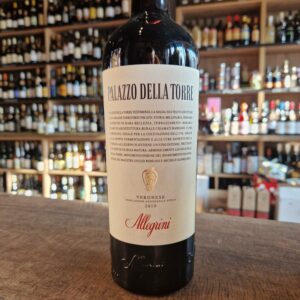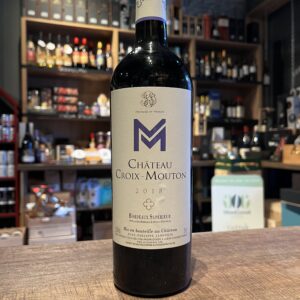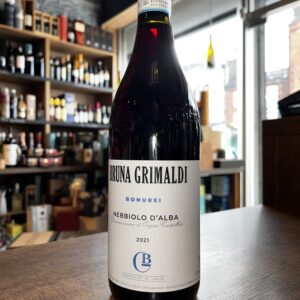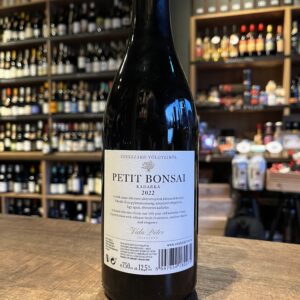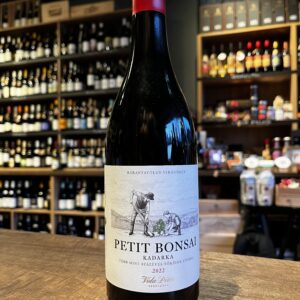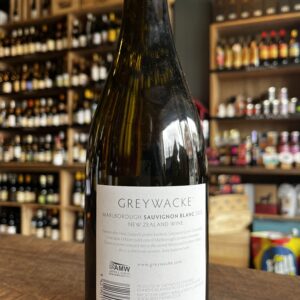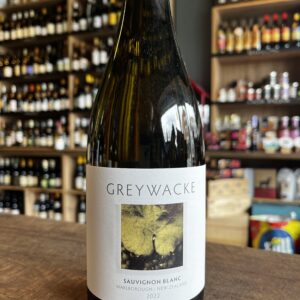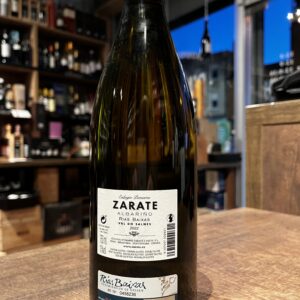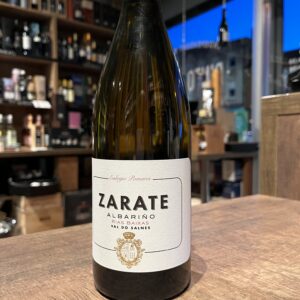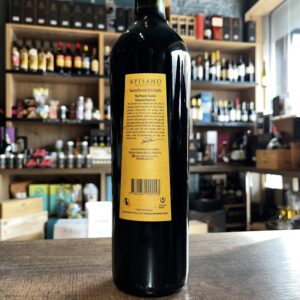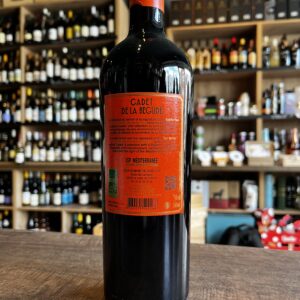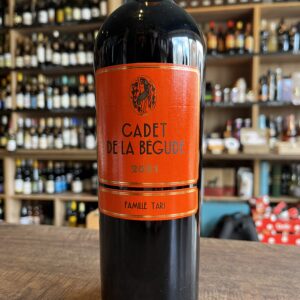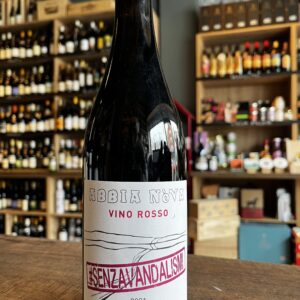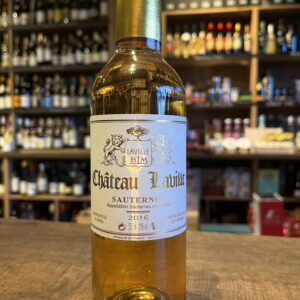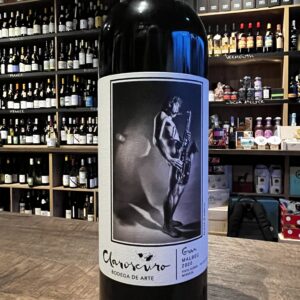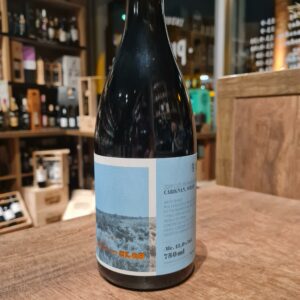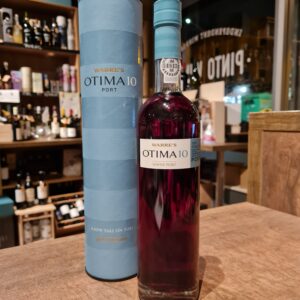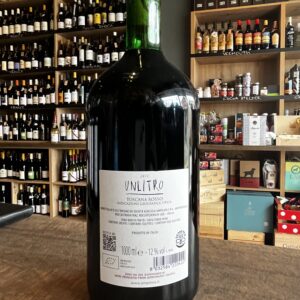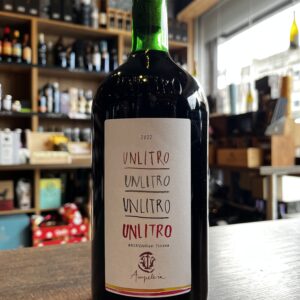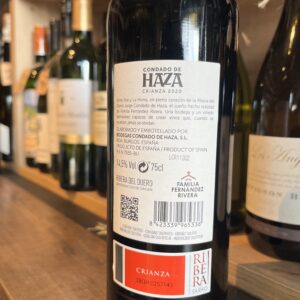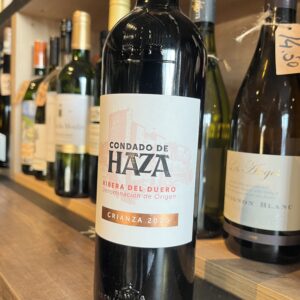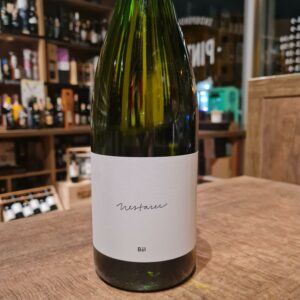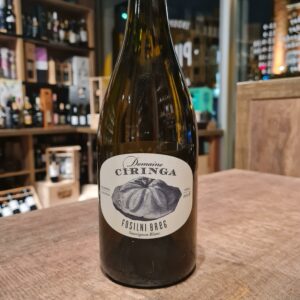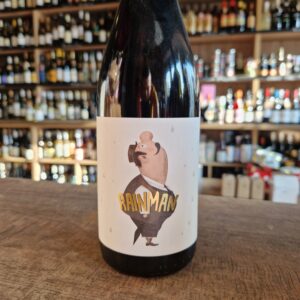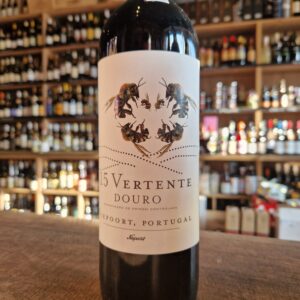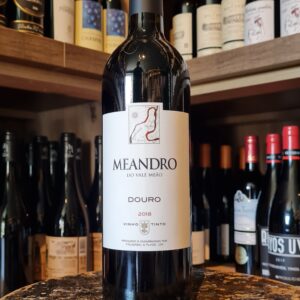-
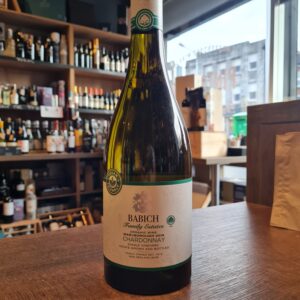 Family Estates Organic Marlborough Chardonnay; a complex style of Chardonnay grown in our Headwaters vineyard in Marlborough. The cooler climate and alluvial soils of Marlborough deliver flavour and varietal complexity that is reflective of the region and our winemaker’s commitment to sustainably crafting the most drinkable New Zealand wines in the world. This organic Chardonnay wine would go well with poultry or fish or vegetable medley.
Family Estates Organic Marlborough Chardonnay; a complex style of Chardonnay grown in our Headwaters vineyard in Marlborough. The cooler climate and alluvial soils of Marlborough deliver flavour and varietal complexity that is reflective of the region and our winemaker’s commitment to sustainably crafting the most drinkable New Zealand wines in the world. This organic Chardonnay wine would go well with poultry or fish or vegetable medley. -
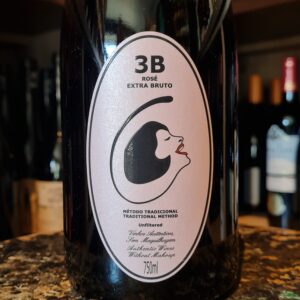 The Filipa Pato 3B Sparkling Rosé is a delicious treat of a wine from one of my favorite winemakers in Portugal. Filipa Pato is the daughter of arguably one of Portugal's most famous winemakers, Luis Pato. Passion for the traditional indigenous grape varietals of Bairrada led Filipa Pato to start her own project in 2001. She works a total of 12 hectares of vineyards scattered in various plots throughout the Bairrada appellation of Portugal. Utilizing biodynamic farming practices and minimal-intervention winemaking. The 3B is a homage to the traditional sparkling wines of Bairrada, with this being a blend of the indigenous Baga and Bical grapes. The Bical adds mineral and citrus notes to the berry red fruit notes of the Baga. This is a great little sparkler with a dry finish. Filipa and her husband, Belgian sommelier and restaurateur William Wouters, produce vinhos autênticos sem maquilagem – 'Authentic Wines Without Makeup.' 3B's-Bairrada, Baga & Bical
The Filipa Pato 3B Sparkling Rosé is a delicious treat of a wine from one of my favorite winemakers in Portugal. Filipa Pato is the daughter of arguably one of Portugal's most famous winemakers, Luis Pato. Passion for the traditional indigenous grape varietals of Bairrada led Filipa Pato to start her own project in 2001. She works a total of 12 hectares of vineyards scattered in various plots throughout the Bairrada appellation of Portugal. Utilizing biodynamic farming practices and minimal-intervention winemaking. The 3B is a homage to the traditional sparkling wines of Bairrada, with this being a blend of the indigenous Baga and Bical grapes. The Bical adds mineral and citrus notes to the berry red fruit notes of the Baga. This is a great little sparkler with a dry finish. Filipa and her husband, Belgian sommelier and restaurateur William Wouters, produce vinhos autênticos sem maquilagem – 'Authentic Wines Without Makeup.' 3B's-Bairrada, Baga & Bical -
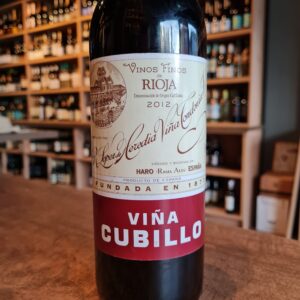 Viña Cubillo wines come from the vineyard called Viña Cubillas, some 4 km away from the bodega, which as with all of the other vineyards, was bought by our founder. Historically these wines were called "Special Harvest". For 143 years, four generations of the López de Heredia family have devoted themselves to producing exceptional and unique wines. Masterpieces which have achieved that which the founder of the company, Rafael López de Heredia y Landeta, defined in the late nineteenth century as the "Supreme Rioja". Vineyard care, a scrupulous selection of grapes, ageing in oak barrels in the heart of deep underground galleries, and the later ageing in bottles, all contribute to making these illustrious wines with their exceptional bouquet. Decant it for an hour if possible, It goes perfectly with all meat dishes, tapas and assorted antipasti, sausages, small game and wild mushrooms.
Viña Cubillo wines come from the vineyard called Viña Cubillas, some 4 km away from the bodega, which as with all of the other vineyards, was bought by our founder. Historically these wines were called "Special Harvest". For 143 years, four generations of the López de Heredia family have devoted themselves to producing exceptional and unique wines. Masterpieces which have achieved that which the founder of the company, Rafael López de Heredia y Landeta, defined in the late nineteenth century as the "Supreme Rioja". Vineyard care, a scrupulous selection of grapes, ageing in oak barrels in the heart of deep underground galleries, and the later ageing in bottles, all contribute to making these illustrious wines with their exceptional bouquet. Decant it for an hour if possible, It goes perfectly with all meat dishes, tapas and assorted antipasti, sausages, small game and wild mushrooms. -
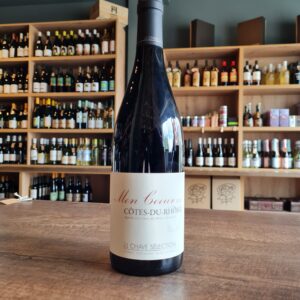 Domaine Jean-Louis Chave is one of the finest producers in the Northern Rhone. 16 generations of wine making has led to mastery of their art. This astonishing experience and expertise is pervasive in this wine. This deliciously ripe Syrah/Grenache blend has a wonderful core of dark, berry fruit supported by a framework of ripe tannin with cooling, granitic notes and a sleek, sophisticated texture. The sublime quality of the wines at this Domaine have meant that there has always been a long queue of Wine Merchants desperate for a glimpse of the Chave cellars. Gerard's son, Jean-Louis makes the wine at the Estate now and his ideal is to produce wine that is as pure an expression of the grape and terroir as possible. He achieves this by only vinifying the healthiest grapes produced from low yielding vines, intervening as little as possible while making the wine and bottling without filtration. His wines are some of the Rhône’s most complete and sophisticated examples. Jean Louis Chaves' selection wines are benchmarks of the Rhone, packed with regional character, that are made from a mixture of declassified Domaine fruit and grapes that are grown by Jean-Louis in conjunction with other vignobles. After tasting this gorgeous wine, I understood the name "Mon Coeur".
Domaine Jean-Louis Chave is one of the finest producers in the Northern Rhone. 16 generations of wine making has led to mastery of their art. This astonishing experience and expertise is pervasive in this wine. This deliciously ripe Syrah/Grenache blend has a wonderful core of dark, berry fruit supported by a framework of ripe tannin with cooling, granitic notes and a sleek, sophisticated texture. The sublime quality of the wines at this Domaine have meant that there has always been a long queue of Wine Merchants desperate for a glimpse of the Chave cellars. Gerard's son, Jean-Louis makes the wine at the Estate now and his ideal is to produce wine that is as pure an expression of the grape and terroir as possible. He achieves this by only vinifying the healthiest grapes produced from low yielding vines, intervening as little as possible while making the wine and bottling without filtration. His wines are some of the Rhône’s most complete and sophisticated examples. Jean Louis Chaves' selection wines are benchmarks of the Rhone, packed with regional character, that are made from a mixture of declassified Domaine fruit and grapes that are grown by Jean-Louis in conjunction with other vignobles. After tasting this gorgeous wine, I understood the name "Mon Coeur". -
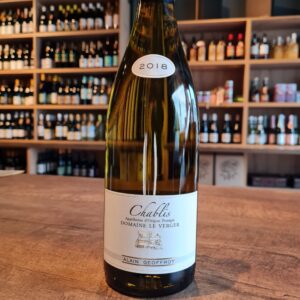 Domaine Le Verger Chablis is light gold, pronounced white flowers, mingled with an array of tropical and sweet stone fruit on the nose. The palate opens full and round, with pineapple, apricot and hints of grapefruit, hints of vegetal and lively minerality finishing fresh with great structure and dry. An excellent Chardonnay that should not be over-chilled, please allow to-open and would be best served with oysters, shellfish in general, grilled fish and even chicken. A classic Chablis at an affordable price!
Domaine Le Verger Chablis is light gold, pronounced white flowers, mingled with an array of tropical and sweet stone fruit on the nose. The palate opens full and round, with pineapple, apricot and hints of grapefruit, hints of vegetal and lively minerality finishing fresh with great structure and dry. An excellent Chardonnay that should not be over-chilled, please allow to-open and would be best served with oysters, shellfish in general, grilled fish and even chicken. A classic Chablis at an affordable price! -

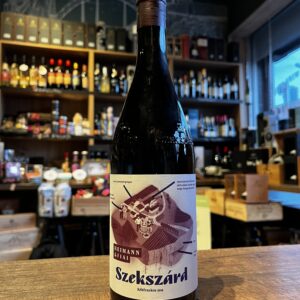 "I don’t think there is a better description for this wine than vin de soif. A wine that really does make you thirsty for the next sip! (The next glass!) It has the quiet charcuterie-like meatiness of Cinsault on the nose along with woodsy florals and tomato vine. It tastes of bramble berries picked from late-summer hedgerows, warm from the sun but with the leafiness and fragrant earthiness of footpaths and damp grassy banks and wild herbs. So mouth-watering and so gentle." Tamlyn Currin, Jancis Robinson.com
"I don’t think there is a better description for this wine than vin de soif. A wine that really does make you thirsty for the next sip! (The next glass!) It has the quiet charcuterie-like meatiness of Cinsault on the nose along with woodsy florals and tomato vine. It tastes of bramble berries picked from late-summer hedgerows, warm from the sun but with the leafiness and fragrant earthiness of footpaths and damp grassy banks and wild herbs. So mouth-watering and so gentle." Tamlyn Currin, Jancis Robinson.com -
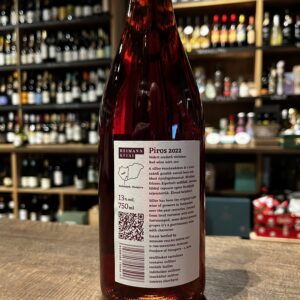
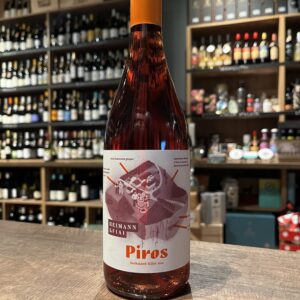 Siller has been the original table wine of growers in Szekszárd over the past centuries. Created from local varieties with some footstomped, some direct pressed grapes it’s a gastronomic wine with character. Fermented and aged in concrete. Stems add woodiness, but no barrels were used. Sagrantino gives a touch of grip, while Kékfrankos and Merlot add fruit, meatiness. Spicy, fresh, and chillable from Southern Hungary.
Siller has been the original table wine of growers in Szekszárd over the past centuries. Created from local varieties with some footstomped, some direct pressed grapes it’s a gastronomic wine with character. Fermented and aged in concrete. Stems add woodiness, but no barrels were used. Sagrantino gives a touch of grip, while Kékfrankos and Merlot add fruit, meatiness. Spicy, fresh, and chillable from Southern Hungary. -
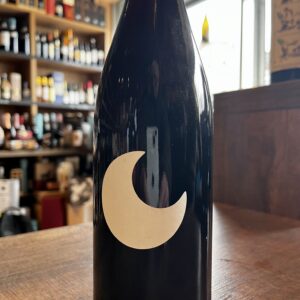
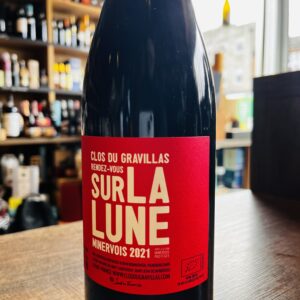 This Sur La Lune from Le Clos du Gravillas is a dazzling expanse of white limestone pebbles on a plateau at an altitude of 300 meters in the Haut Languedoc Natural Park. Between the gorges of St Chinian and Minerve, surrounded by scrubland and holm oaks, the 8.30 hectare estate is managed with respect for the terroir, in organic farming with concern for the preservation of the biodiversity of fauna and the surrounding flora. This wine comes from 3 plots on the Cazelles plateau: Syrah from a place called “Esperandieu”, a very pretty place surrounded by hills covered with scrubland, almond trees, broom and oaks where they also planted 48 pomegranate trees, 25 fig trees as well as cherry and apricot trees. The 80 year old vine of Carignan planted with Grenache from the place called Carretals and the 40-year-old Carignan vine from the place called Roque de Beau. Serve rather chilled but not too cold, ensuring that the wine does not heat up excessively in the bottle or in the glasses. A slight opening time prior to service may be beneficial.vThis wine beyond all the technicallities and sense of place it is a straight wine without organoleptic deviation, without volatile phenols, pure, with perfect control and ultimately delicious. Slainte!
This Sur La Lune from Le Clos du Gravillas is a dazzling expanse of white limestone pebbles on a plateau at an altitude of 300 meters in the Haut Languedoc Natural Park. Between the gorges of St Chinian and Minerve, surrounded by scrubland and holm oaks, the 8.30 hectare estate is managed with respect for the terroir, in organic farming with concern for the preservation of the biodiversity of fauna and the surrounding flora. This wine comes from 3 plots on the Cazelles plateau: Syrah from a place called “Esperandieu”, a very pretty place surrounded by hills covered with scrubland, almond trees, broom and oaks where they also planted 48 pomegranate trees, 25 fig trees as well as cherry and apricot trees. The 80 year old vine of Carignan planted with Grenache from the place called Carretals and the 40-year-old Carignan vine from the place called Roque de Beau. Serve rather chilled but not too cold, ensuring that the wine does not heat up excessively in the bottle or in the glasses. A slight opening time prior to service may be beneficial.vThis wine beyond all the technicallities and sense of place it is a straight wine without organoleptic deviation, without volatile phenols, pure, with perfect control and ultimately delicious. Slainte! -
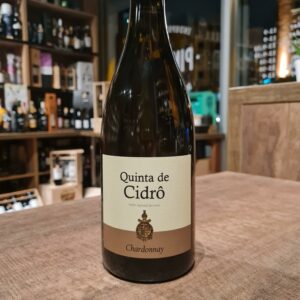 Quinta de Cidrô is located at São João da Pesqueira, which is one of the most highly regarded areas of Douro Valley. Throughout the last 20 years, Cidrô has been transformed into an experimental-model vineyard for the entire region. In virgin soils, cutting edge techniques were employed to plant 150 ha of the best varieties, creating one of the largest surfaces of single vineyard in the entire Douro Region. In the most privileged location, international varieties perform equally well as the local grapes. Chardonnay, Sauvignon Blanc, Viognier, Pinot Noir, and the adaptable Cabernet Sauvignon are some of the foreign varieties that here express their best qualities when vinified by the extensive winemaking know-how present at the Company. The Quinta de Cidrô Sauvignon Blanc was the second result of the ongoing experimentation-taking place at this vineyard.
Quinta de Cidrô is located at São João da Pesqueira, which is one of the most highly regarded areas of Douro Valley. Throughout the last 20 years, Cidrô has been transformed into an experimental-model vineyard for the entire region. In virgin soils, cutting edge techniques were employed to plant 150 ha of the best varieties, creating one of the largest surfaces of single vineyard in the entire Douro Region. In the most privileged location, international varieties perform equally well as the local grapes. Chardonnay, Sauvignon Blanc, Viognier, Pinot Noir, and the adaptable Cabernet Sauvignon are some of the foreign varieties that here express their best qualities when vinified by the extensive winemaking know-how present at the Company. The Quinta de Cidrô Sauvignon Blanc was the second result of the ongoing experimentation-taking place at this vineyard. -
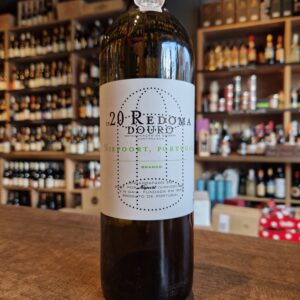 This oaky white will appeal to Graves or Burgundy lovers. The grapes used for the Redoma Branco originate from old vines growing on the right bank of the Douro River, at an altitude of between 400 and 600 metres. These vines predominantly grow in mica-schist soils, which, in combination with the complexity of the various grape varieties typical of the Douro region, create delicate wines full of freshness and minerality. Food suggestions-Oysters, oven-baked fish, poultry and other white meats. Vegetarian options: dishes based on root vegetables (turnips, sweet potato, beetroot), Caesar salad, cheese.
This oaky white will appeal to Graves or Burgundy lovers. The grapes used for the Redoma Branco originate from old vines growing on the right bank of the Douro River, at an altitude of between 400 and 600 metres. These vines predominantly grow in mica-schist soils, which, in combination with the complexity of the various grape varieties typical of the Douro region, create delicate wines full of freshness and minerality. Food suggestions-Oysters, oven-baked fish, poultry and other white meats. Vegetarian options: dishes based on root vegetables (turnips, sweet potato, beetroot), Caesar salad, cheese. -
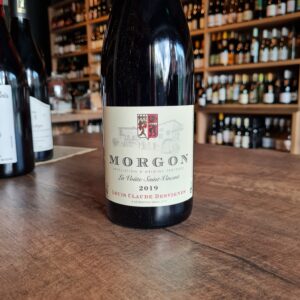 Louis-Claude Desvignes is a family estate that dates back to 1700. The Desvignes range is "La Voûte Saint Vincent", named for the vault or "voûte" of the old family house and for the patron saint of winemakers. It was Louis-Claude who began to turn the estate’s grapes into wine, and now with the reins handed over to his two sons Louis-Benoît and Claude-Emmanuelle Desvignes. It is a blend of certified-organic estate parcels totalling 4.5 hectares in the climat of Douby, which lies in the northeast corner of Morgon along the border of Fleurie. The La Voûte vines average 50 years old and are planted in Douby's typical sandy, decomposed-granite soils. Viticulture and vinification are consistent across all Desvignes wines. In the case of La Voûte, the parcels are all vinified separately.
Louis-Claude Desvignes is a family estate that dates back to 1700. The Desvignes range is "La Voûte Saint Vincent", named for the vault or "voûte" of the old family house and for the patron saint of winemakers. It was Louis-Claude who began to turn the estate’s grapes into wine, and now with the reins handed over to his two sons Louis-Benoît and Claude-Emmanuelle Desvignes. It is a blend of certified-organic estate parcels totalling 4.5 hectares in the climat of Douby, which lies in the northeast corner of Morgon along the border of Fleurie. The La Voûte vines average 50 years old and are planted in Douby's typical sandy, decomposed-granite soils. Viticulture and vinification are consistent across all Desvignes wines. In the case of La Voûte, the parcels are all vinified separately. -
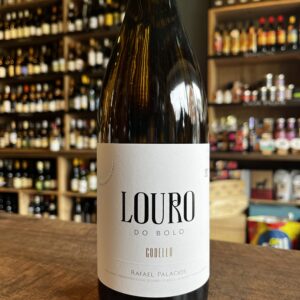 The best white wines of Spain are made of Godello from the region Valdeorras in Galicia. More and more this wine is can be seen in many wine lists across Ireland as its increasing popularity is par to the Albarino from Rias baixas or the Rueda's Verdejo. Rafael Palacios the maker of this wine comes from something of a winemaking dynasty. His father, uncle and brother are all highly regarded winemakers across Rioja, Priorat and other parts of the country. Rafael himself cut his teeth working on his father's Rioja estate, prior to training and working in Bordeaux and Coonawarra, South Australia. Rafa started this project in 2004 in the then little known region of Valdeorras, home of a few ancient plots of Godello vines. This grape variety was virtually extinct in Spain but Rafa and a few others realised its potential and extensive replanting of the variety began. The Louro is crafted from younger vines but is selected from plots that produce more age-worthy wines. Fermented with indigenous yeast and aged in used foudre, Louro showcases Rafa’s talent at balancing the minerality of the grape with the richness and texture of the élevage. Pair it with baked whitefish, bluefish, fish and vegetables, grilled fish, grilled whitefish, pasta with fish, poultry, rice with fish, roasted fish, roasted foods.
The best white wines of Spain are made of Godello from the region Valdeorras in Galicia. More and more this wine is can be seen in many wine lists across Ireland as its increasing popularity is par to the Albarino from Rias baixas or the Rueda's Verdejo. Rafael Palacios the maker of this wine comes from something of a winemaking dynasty. His father, uncle and brother are all highly regarded winemakers across Rioja, Priorat and other parts of the country. Rafael himself cut his teeth working on his father's Rioja estate, prior to training and working in Bordeaux and Coonawarra, South Australia. Rafa started this project in 2004 in the then little known region of Valdeorras, home of a few ancient plots of Godello vines. This grape variety was virtually extinct in Spain but Rafa and a few others realised its potential and extensive replanting of the variety began. The Louro is crafted from younger vines but is selected from plots that produce more age-worthy wines. Fermented with indigenous yeast and aged in used foudre, Louro showcases Rafa’s talent at balancing the minerality of the grape with the richness and texture of the élevage. Pair it with baked whitefish, bluefish, fish and vegetables, grilled fish, grilled whitefish, pasta with fish, poultry, rice with fish, roasted fish, roasted foods. -
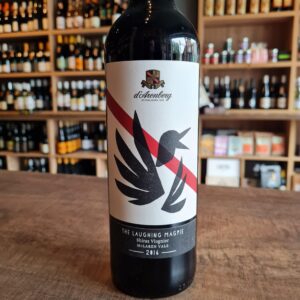 The Kookaburra is a native Australian bird famous for its distinctive laughing call, Chester's young daughters named them 'Laughing Magpies'. The Magpie plumage is black with a stripe of white feathers, representing McLaren Vale's first ever blend combining the (black) Shiraz and its white partner, Viognier. An enticing mix of primary fruit characters entwined with flowers, ginger and stone fruit. A rather dark appearance with a vivid purple hue suggesting a complex dry red. The nose is particularly intense, with peppery spice, hints of fragrant flower and perfume aromas, plus nectarines, apricots, ginger and herbs from the small parcel of viognier that the Shiraz is co-fermented with. On the palate the Shiraz is more dominant. There is some sweeter fruit characters like blackberry, blueberry and boysenberry. The palate is rich and generous and soft silky tannins. Would open 2 hours before serving and use a Decanter when possible. Enjoy this dry red wine from Australia with fillet of beef, dark meat dishes like goulash or the Asian classic Peking duck.
The Kookaburra is a native Australian bird famous for its distinctive laughing call, Chester's young daughters named them 'Laughing Magpies'. The Magpie plumage is black with a stripe of white feathers, representing McLaren Vale's first ever blend combining the (black) Shiraz and its white partner, Viognier. An enticing mix of primary fruit characters entwined with flowers, ginger and stone fruit. A rather dark appearance with a vivid purple hue suggesting a complex dry red. The nose is particularly intense, with peppery spice, hints of fragrant flower and perfume aromas, plus nectarines, apricots, ginger and herbs from the small parcel of viognier that the Shiraz is co-fermented with. On the palate the Shiraz is more dominant. There is some sweeter fruit characters like blackberry, blueberry and boysenberry. The palate is rich and generous and soft silky tannins. Would open 2 hours before serving and use a Decanter when possible. Enjoy this dry red wine from Australia with fillet of beef, dark meat dishes like goulash or the Asian classic Peking duck. -
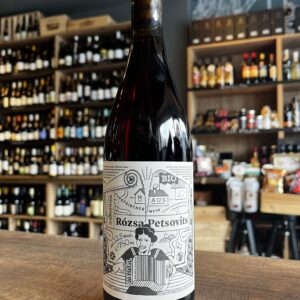 Rózsa Petsovits was born in 1921 in Horitschon, Hungary. In the same year Horitschon came to Austria. Just as the history of Burgenland is a history of German-speaking Hungary, so this wine tries to think without borders. Blaufänkisch grown on loam and Pinot Noir on limestone fom Austria mingle with Syrah and Zweigelt on gneiss from Hungary. A rosé to remember, dedicated to Franz Weninger's very active grandmother, Rozsa Petsovits. The perfect wine for summertime.
Rózsa Petsovits was born in 1921 in Horitschon, Hungary. In the same year Horitschon came to Austria. Just as the history of Burgenland is a history of German-speaking Hungary, so this wine tries to think without borders. Blaufänkisch grown on loam and Pinot Noir on limestone fom Austria mingle with Syrah and Zweigelt on gneiss from Hungary. A rosé to remember, dedicated to Franz Weninger's very active grandmother, Rozsa Petsovits. The perfect wine for summertime. -
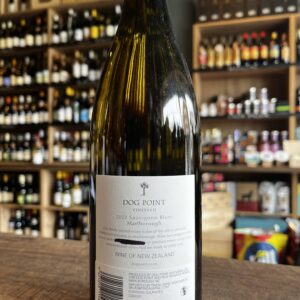
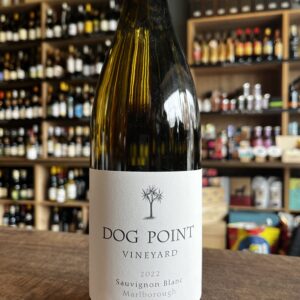 Dog Point Vineyard is New Zealand's largest certified organic vineyard by Biogro NZ. We are family owned and one of the oldest privately established vineyards, located on the hill slopes of the Southern Valleys of Marlborough, New Zealand. Marlborough is blessed with one of the sunniest and driest climates in New Zealand. The significant diurnal temperature range between cool nights and sunny days allows ideal conditions for the long slow ripening of grapes. Soils are crucial to the character of our wine. Most soils have been laid down within the last 14,000 years carved and eroded by glaciers in the high country and carried down to the coast by melt-water rivers. Older well-established vines are situated on free draining silty clay loams. This is supplemented with more recent plantings on closely planted hillside blocks on soils with a clay loam influence. Pair with fresh, simple seafood dishes especially oysters. Also compliments goat's cheese well
Dog Point Vineyard is New Zealand's largest certified organic vineyard by Biogro NZ. We are family owned and one of the oldest privately established vineyards, located on the hill slopes of the Southern Valleys of Marlborough, New Zealand. Marlborough is blessed with one of the sunniest and driest climates in New Zealand. The significant diurnal temperature range between cool nights and sunny days allows ideal conditions for the long slow ripening of grapes. Soils are crucial to the character of our wine. Most soils have been laid down within the last 14,000 years carved and eroded by glaciers in the high country and carried down to the coast by melt-water rivers. Older well-established vines are situated on free draining silty clay loams. This is supplemented with more recent plantings on closely planted hillside blocks on soils with a clay loam influence. Pair with fresh, simple seafood dishes especially oysters. Also compliments goat's cheese well -
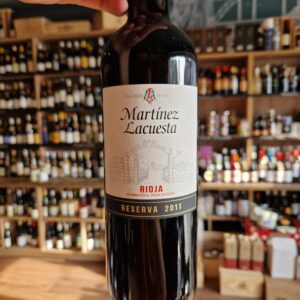 Bodegas Martínez Lacuesta was founded in 1895 in Haro by Félix Martínez Lacuesta. A winemaker, lawyer, politician and publicist, he was the first president of the National Association of Winegrowers and Wine Industries, as well as of the Rioja Wine Union. He was also one of the creators of the Regulating Board of D.O. Rioja, where he represented his fellow winemakers. The philosophy of this century-old winery is to produce the best wines from the best grapes. To do so, they have plots distributed throughout Rioja Alta, searching for the best vineyards and buying, up until this day, new plots to plant new vines. Martínez Lacuesta Reserva is a wine made from Tempranillo, Graciano and Mazuelo, from vineyards located at 450-600 metres of altitude. Their vines, of an average of 25 years old, are planted on clayey-calcareous soils. Suitable to accompany white or red meats, fishes with sauce, grilled meat or vegetables
Bodegas Martínez Lacuesta was founded in 1895 in Haro by Félix Martínez Lacuesta. A winemaker, lawyer, politician and publicist, he was the first president of the National Association of Winegrowers and Wine Industries, as well as of the Rioja Wine Union. He was also one of the creators of the Regulating Board of D.O. Rioja, where he represented his fellow winemakers. The philosophy of this century-old winery is to produce the best wines from the best grapes. To do so, they have plots distributed throughout Rioja Alta, searching for the best vineyards and buying, up until this day, new plots to plant new vines. Martínez Lacuesta Reserva is a wine made from Tempranillo, Graciano and Mazuelo, from vineyards located at 450-600 metres of altitude. Their vines, of an average of 25 years old, are planted on clayey-calcareous soils. Suitable to accompany white or red meats, fishes with sauce, grilled meat or vegetables -
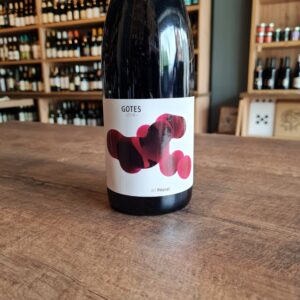 Gotes was the last to be incorporated into the Portal del Priorat's wine family, the Alfredo Arribas project in this denomination, and was envisioned to highlight the freshness of Priorat wines; gotes (drops) of freshness, like dewdrops. Don't expect to find in Gotes the more usual Priorat typicity, with profound maturity and intense minerality. Gotes reflects another type of Priorat wine, refined, in the French style (we mean 'French' as in Burgundy), with a fresh and floral profile. The typicity of Gotes is rooted in the countryside, in its notes of aromatic plants, and in that delightful warmth, because although fresh it is Mediterranean. Another special feature of Gotes is the polish and attention to detail it emits; it's an elegant wine; it has clearly been crafted by experts. If Gotes is refined on the nose, it's positively explosive on the palate! It grows and grows, with lots of volume and a very seductive sweetness and velvety texture. Gotes is fruit, but a very varied fruit cocktail: red fruits, black fruits, both fresh and jammy, the odd juicy stone fruit like mango (the Garnacha always leaves its mark) and fresh grapes that provide a citrusy touch. Ideal with dishes of a upper middle power taste. Will be excellent with a salad of figs and duck ham with Parmesan shavings. It will also be great taking with red meats, duck breast grilled or thigh kid with cider and soft alioli.
Gotes was the last to be incorporated into the Portal del Priorat's wine family, the Alfredo Arribas project in this denomination, and was envisioned to highlight the freshness of Priorat wines; gotes (drops) of freshness, like dewdrops. Don't expect to find in Gotes the more usual Priorat typicity, with profound maturity and intense minerality. Gotes reflects another type of Priorat wine, refined, in the French style (we mean 'French' as in Burgundy), with a fresh and floral profile. The typicity of Gotes is rooted in the countryside, in its notes of aromatic plants, and in that delightful warmth, because although fresh it is Mediterranean. Another special feature of Gotes is the polish and attention to detail it emits; it's an elegant wine; it has clearly been crafted by experts. If Gotes is refined on the nose, it's positively explosive on the palate! It grows and grows, with lots of volume and a very seductive sweetness and velvety texture. Gotes is fruit, but a very varied fruit cocktail: red fruits, black fruits, both fresh and jammy, the odd juicy stone fruit like mango (the Garnacha always leaves its mark) and fresh grapes that provide a citrusy touch. Ideal with dishes of a upper middle power taste. Will be excellent with a salad of figs and duck ham with Parmesan shavings. It will also be great taking with red meats, duck breast grilled or thigh kid with cider and soft alioli. -
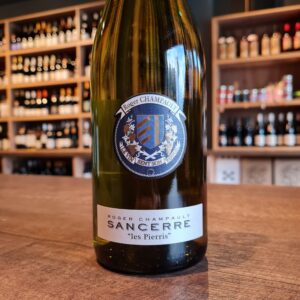 Five generations of traditional winemaking from the estate of Roger Champault, modern thermoregulation techniques, and carefully chosen soil matching, have produced a Cuvee that is subtle at first, like the rising of a summer breeze, building in its complexity with wispy herbal notes and abundant florals that dance across the taste buds like wind through an apple orchard. Delicate, yet so very alive. This wine drinks with a lovely, masterfully structured liveliness and sweet, concentrated finish.Thanks to its abundant fruitiness, it is suitable not only for seafood and crabs but also for more abundant fish dishes; fried salmon, pike perch etc. Also suitable for light meat, especially poultry dishes.Curious note, Sancerre Les Pierris 2008 wine was served at the wedding dinner of Princess Victoria and Daniel of Sweden.
Five generations of traditional winemaking from the estate of Roger Champault, modern thermoregulation techniques, and carefully chosen soil matching, have produced a Cuvee that is subtle at first, like the rising of a summer breeze, building in its complexity with wispy herbal notes and abundant florals that dance across the taste buds like wind through an apple orchard. Delicate, yet so very alive. This wine drinks with a lovely, masterfully structured liveliness and sweet, concentrated finish.Thanks to its abundant fruitiness, it is suitable not only for seafood and crabs but also for more abundant fish dishes; fried salmon, pike perch etc. Also suitable for light meat, especially poultry dishes.Curious note, Sancerre Les Pierris 2008 wine was served at the wedding dinner of Princess Victoria and Daniel of Sweden. -

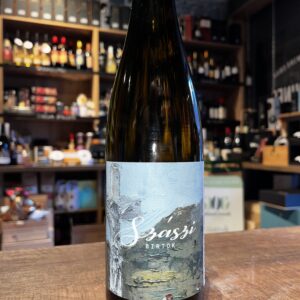 Szászi has one of the first organic certified vineyards in Hungary. The St. George's Hill is their top single vineyard dedicated to Olaszrizling aka. Welschriesling. Contrary to the name it has no genetical connection to the Rhein Valley Riesling. Olaszrizling is a neutral variety meaning that it is a good reflector of the basalt terroir. Its aromas are most commonly characterised by almond blossom and hazelnut. Olaszrizling wines are a real representation of the Lake Balaton feeling, as the variety can be found in almost every cellar on the north shore. Olaszrizling made in a really light, fresh neutral style is one of the great summer classics. This style of light Olaszrizling is the perfect accompaniment for summer barbecues and light salad or vegetable dishes. Olaszrizling can also demonstrate a more serious side with the right attention in the vineyards and winery. In this case, its flavours are accompanied by an oily, dense texture, greater depth and often a more mineral character. These premium Olaszrizlings are real foodie wines and also benefit from a few years of bottle age.
Szászi has one of the first organic certified vineyards in Hungary. The St. George's Hill is their top single vineyard dedicated to Olaszrizling aka. Welschriesling. Contrary to the name it has no genetical connection to the Rhein Valley Riesling. Olaszrizling is a neutral variety meaning that it is a good reflector of the basalt terroir. Its aromas are most commonly characterised by almond blossom and hazelnut. Olaszrizling wines are a real representation of the Lake Balaton feeling, as the variety can be found in almost every cellar on the north shore. Olaszrizling made in a really light, fresh neutral style is one of the great summer classics. This style of light Olaszrizling is the perfect accompaniment for summer barbecues and light salad or vegetable dishes. Olaszrizling can also demonstrate a more serious side with the right attention in the vineyards and winery. In this case, its flavours are accompanied by an oily, dense texture, greater depth and often a more mineral character. These premium Olaszrizlings are real foodie wines and also benefit from a few years of bottle age. -
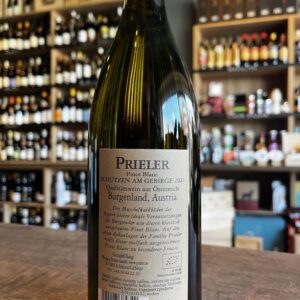
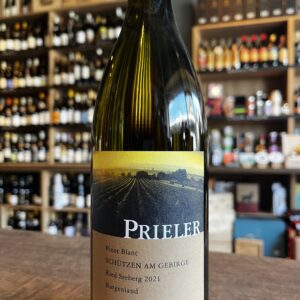 Old vines are the fortune of every vintner. They root deeply and lend their intrinsic potential a persistent voice. Pinot Blanc, also locally called Weissburgunder, has a long tradition in our region. My grandfather planted most of our vines in the limestone of the Seeberg site 60 years ago. A few were even planted by my grandfather over 90 years ago. It is my duty today to continue to tell the story that the two of them began.
Old vines are the fortune of every vintner. They root deeply and lend their intrinsic potential a persistent voice. Pinot Blanc, also locally called Weissburgunder, has a long tradition in our region. My grandfather planted most of our vines in the limestone of the Seeberg site 60 years ago. A few were even planted by my grandfather over 90 years ago. It is my duty today to continue to tell the story that the two of them began. -
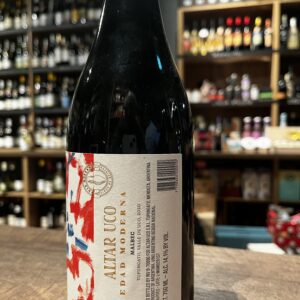
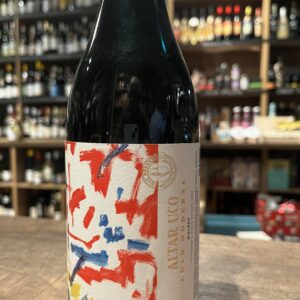 "The young and tender 2020 Edad Moderna Malbec feels a bit raw and wild, showing the character of the place. It is a bit riper, reflecting a warmer and drier year, showing notes of licorice and black cherries. It fermented in raw concrete, where it matured for eight months. It's a bit chewy with faint rusticity, and it developed balsamic nuances with time in the glass"
"The young and tender 2020 Edad Moderna Malbec feels a bit raw and wild, showing the character of the place. It is a bit riper, reflecting a warmer and drier year, showing notes of licorice and black cherries. It fermented in raw concrete, where it matured for eight months. It's a bit chewy with faint rusticity, and it developed balsamic nuances with time in the glass" -
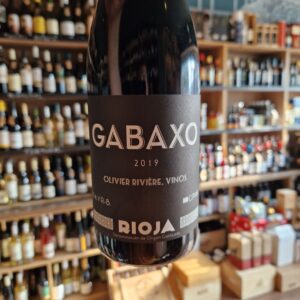
Rioja Gabaxo Olivier Riviere Biodynamic Wine, Wild yeast, French oak Maturation, full bodied but beautifully fresh and balanced. No new oak in Gabacho, but loads of classy Rioja character and sheer drinkability! Gabacho does see some wood, a small amount of old french barrels are used for ageing up to a year. This adds no flavour but helps to soften the wine slightly. This really is lovely stuff, rich but very fresh and balanced red wine with a touch of the dark and brooding about it and a touch of the animal too. It benefits from decanting and also from good bottle ageing. Try it, it will change your mind about Rioja
-
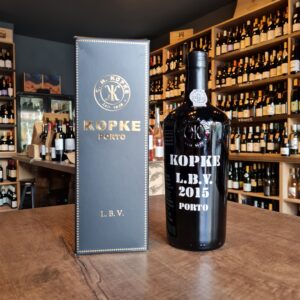 The wine owes its name to the port city of Porto, but comes from the Douro Valley. Here you will find one of the most spectacular wine landscapes in the world with terraced vineyards on steep slopes. It is scorching hot in summer, freezing cold in winter. The Douro Valley was already demarcated in 1756, making it the oldest regulated area of origin in the world. Port itself is a fortified wine. By interrupting the fermentation by adding wine alcohol, the wine retains its residual sugars and also gets its relatively high alcohol percentage. Port does not stand for a single wine, but for a whole series of wines. Wines with very different styles and tastes due to differences in the blending and aging of the base wines. In 1636 Nicolau Kopkë settled in Portugal as 'consul general' (a kind of representative) of the Hanseatic League, a partnership between merchants and cities, during the Middle Ages. Two years later, the first bottles of wine were shipped to Northern Europe. And when Nicolau bought a farm in the Douro in 1781, he changed from buyer to producer. Port wine soon became the focus of the company. Kpke now is one of the oldest Port Wine House. Recognized by the variety and distinction of its Ports, Kopke represents in XXI century a symbol of quality and prestige. LBV stands for Late Bottle Vintage and is the result of single year's harvest of superior quality, aged in oak Vats. Balancing the intensity of flavours, the Late Bottled Vintage Port is the ideal choice to serve with main courses of meat, like filet mignon encrusted four peppers and veal cutlet with Bérnaise sauce. Its versatility knows no borders, being perfect to combine with an exuberant cheesecake of chocolate mint, a pear and chocolate mille-feuille or simply to enjoy with cheeses of medium intensity.
The wine owes its name to the port city of Porto, but comes from the Douro Valley. Here you will find one of the most spectacular wine landscapes in the world with terraced vineyards on steep slopes. It is scorching hot in summer, freezing cold in winter. The Douro Valley was already demarcated in 1756, making it the oldest regulated area of origin in the world. Port itself is a fortified wine. By interrupting the fermentation by adding wine alcohol, the wine retains its residual sugars and also gets its relatively high alcohol percentage. Port does not stand for a single wine, but for a whole series of wines. Wines with very different styles and tastes due to differences in the blending and aging of the base wines. In 1636 Nicolau Kopkë settled in Portugal as 'consul general' (a kind of representative) of the Hanseatic League, a partnership between merchants and cities, during the Middle Ages. Two years later, the first bottles of wine were shipped to Northern Europe. And when Nicolau bought a farm in the Douro in 1781, he changed from buyer to producer. Port wine soon became the focus of the company. Kpke now is one of the oldest Port Wine House. Recognized by the variety and distinction of its Ports, Kopke represents in XXI century a symbol of quality and prestige. LBV stands for Late Bottle Vintage and is the result of single year's harvest of superior quality, aged in oak Vats. Balancing the intensity of flavours, the Late Bottled Vintage Port is the ideal choice to serve with main courses of meat, like filet mignon encrusted four peppers and veal cutlet with Bérnaise sauce. Its versatility knows no borders, being perfect to combine with an exuberant cheesecake of chocolate mint, a pear and chocolate mille-feuille or simply to enjoy with cheeses of medium intensity. -
Out of stock
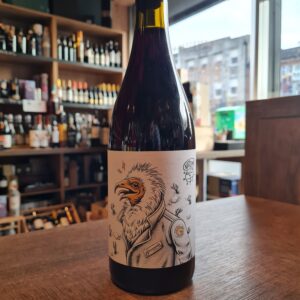 Ricardo Alves and Frederico Machado visited Bemposta for the first time together in 2017. They were on the Portuguese back roads in the Parque Natural das Arribas do Douro, with its wealth of ancient, indigenous and largely forgotten grapevines chaotically perched on the extreme slopes on the Douro river gorge, when they came upon the perfect location for their life project, the place to which they would commit their youth. They set out to rediscover and revitalize an ancient wine culture whose local home winegrowers have just barely kept the faint bloodline of their vinous history from extinction. Trás-os-Montes is a large, but not too well known, wine region of north eastern Portugal (Translation: behind the Mountains), is where the Arribas Wine Company are based and both are very passionate have been making some very interesting wines. Saroto Tinto is made from a small, old parcel of vines comprised of old-fashioned red and white Douro varieties. The resultant wine is full of wild forest fruit, lots of berries with a kick of natural sourness. Plenty of fresh acidity adds juiciness and balances the rustic, grippy tannins, making for quite a light red. Earthy minerality adds extra complexity and the finish is long and moreish. Its bottled unfined and unfiltered so may have natural sediment in the bottle.
Ricardo Alves and Frederico Machado visited Bemposta for the first time together in 2017. They were on the Portuguese back roads in the Parque Natural das Arribas do Douro, with its wealth of ancient, indigenous and largely forgotten grapevines chaotically perched on the extreme slopes on the Douro river gorge, when they came upon the perfect location for their life project, the place to which they would commit their youth. They set out to rediscover and revitalize an ancient wine culture whose local home winegrowers have just barely kept the faint bloodline of their vinous history from extinction. Trás-os-Montes is a large, but not too well known, wine region of north eastern Portugal (Translation: behind the Mountains), is where the Arribas Wine Company are based and both are very passionate have been making some very interesting wines. Saroto Tinto is made from a small, old parcel of vines comprised of old-fashioned red and white Douro varieties. The resultant wine is full of wild forest fruit, lots of berries with a kick of natural sourness. Plenty of fresh acidity adds juiciness and balances the rustic, grippy tannins, making for quite a light red. Earthy minerality adds extra complexity and the finish is long and moreish. Its bottled unfined and unfiltered so may have natural sediment in the bottle. -
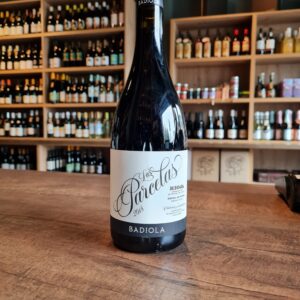 Bodega Badiola, was founded in 2018, part of the Peninsula Vinicultore Group when they bought an old company in the in Rioja Alavesa, the Basque region in the east and south east of Rioja. Their vineyards are situated on the slopes of the Sierra Cantabria, mostly tiny parcels the average size being only 0.3 hectares with an average vine age of 50 years but some of the vines are obviously significantly older. With respect for the environment, minimal spraying of copper and sulphur only are used, so all but Organic. The Las Parcelas comes from 300 carefully selected parcels of old bush Tempranillo vines planted in limestone soils, resulting in elegant wines that are fresh and age worthy due to the balancing acidity. The winemaking philosophy is to keep that purity and freshness by careful use of oak, giving a real point of difference to the traditional oaky Riojas. On the nose and palate, the fruit is very much to the fore with cherry and blackberry fruit with hints of spice and with fresh acidity and almost chalky tannins from that limestone soils. Though it is still young give it some air and it really blossoms, drinking significantly better at dinner rather than lunch when first opened, so will keep well too.
Bodega Badiola, was founded in 2018, part of the Peninsula Vinicultore Group when they bought an old company in the in Rioja Alavesa, the Basque region in the east and south east of Rioja. Their vineyards are situated on the slopes of the Sierra Cantabria, mostly tiny parcels the average size being only 0.3 hectares with an average vine age of 50 years but some of the vines are obviously significantly older. With respect for the environment, minimal spraying of copper and sulphur only are used, so all but Organic. The Las Parcelas comes from 300 carefully selected parcels of old bush Tempranillo vines planted in limestone soils, resulting in elegant wines that are fresh and age worthy due to the balancing acidity. The winemaking philosophy is to keep that purity and freshness by careful use of oak, giving a real point of difference to the traditional oaky Riojas. On the nose and palate, the fruit is very much to the fore with cherry and blackberry fruit with hints of spice and with fresh acidity and almost chalky tannins from that limestone soils. Though it is still young give it some air and it really blossoms, drinking significantly better at dinner rather than lunch when first opened, so will keep well too. -
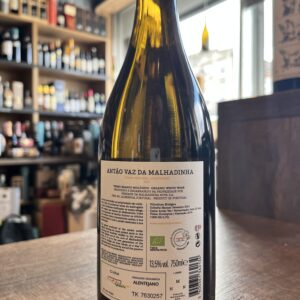
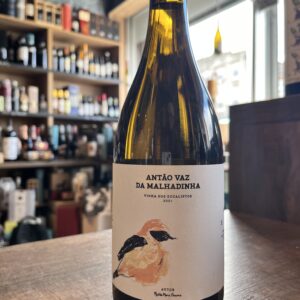 Herdade da Malhadinha Nova is the representation of an ambitious and innovative project of the Soares family, who have transformed a piece of Alentejo land, into one of the most beautiful and charismatic estates in the Alentejo. Located in Albernoa and currently possessing 80 hectares of vineyards, it is here that wines full of personality are created, whose labels are based on the children's drawings of their offspring. In addition to the focus on vines and wine, the estate is also farmed for olive groves and olive oil production, as well as rural and wine tourism activities.
Herdade da Malhadinha Nova is the representation of an ambitious and innovative project of the Soares family, who have transformed a piece of Alentejo land, into one of the most beautiful and charismatic estates in the Alentejo. Located in Albernoa and currently possessing 80 hectares of vineyards, it is here that wines full of personality are created, whose labels are based on the children's drawings of their offspring. In addition to the focus on vines and wine, the estate is also farmed for olive groves and olive oil production, as well as rural and wine tourism activities. -
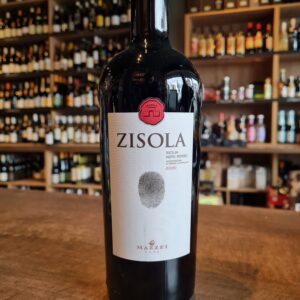 Mazzei is the name of one of the most famous and richest families in the history of Tuscan winemaking, the truth is that their desire to discover and experience other things led them to look for other areas where they could continue their winemaking adventure. So, in 2003, they became aware of the great potential hidden within the Val di Noto region in southeastern Sicily (Italy). A total of 21 hectares of vineyards where Tuscan passion meets Sicilian tradition. Zisola is made only from traditional "Alberello" (bushy) vines grown near Noto, an unique area to make wine. The proximity of the sea and the soil rich in limestone allow to best balance the natural Nero d'Avola exuberance, with a great freshness and elegance. Spicy fish soups, savoury pasta and rice dishes, grilled red meats and vegetables.
Mazzei is the name of one of the most famous and richest families in the history of Tuscan winemaking, the truth is that their desire to discover and experience other things led them to look for other areas where they could continue their winemaking adventure. So, in 2003, they became aware of the great potential hidden within the Val di Noto region in southeastern Sicily (Italy). A total of 21 hectares of vineyards where Tuscan passion meets Sicilian tradition. Zisola is made only from traditional "Alberello" (bushy) vines grown near Noto, an unique area to make wine. The proximity of the sea and the soil rich in limestone allow to best balance the natural Nero d'Avola exuberance, with a great freshness and elegance. Spicy fish soups, savoury pasta and rice dishes, grilled red meats and vegetables. -
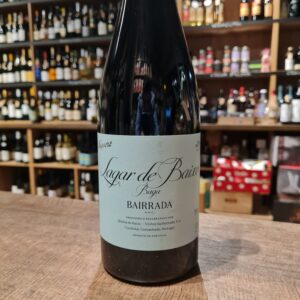 The huge passion of Dirk Niepoort for Baga variety and the fantastic terroir of the Bairrada region led him to look for small parcels of Baga in very old vines, scattered throughout the Cantanhede region, over the past three years. These wines were light in color and alcoholic content, elegant and fine, soon after bottling, but with a huge ageing potential. With the acquisition of the Quinta de Baixo in 2012, it became possible to recreate the Lagar de Baixo brand, moving towards a classically-styled wine which highlights the nobility of Baga grown in Bairrada. The red Lagar de Baixo is the result of a combination of very old vines and younger vines: complex, serious, but with some youth and grip. The 2020 Lagar de Baixo is our most classic wine from Quinta de Baixo and the wine that best reflects the Bairrada terroir. It is fermented in lagares and aged in used barrels. Food Suggestion: Venison dishes (partridge, wild boar), pork and bean stew, baked cod. Vegetarian suggestions: dishes with legumes (red kidney beans, lentils).
The huge passion of Dirk Niepoort for Baga variety and the fantastic terroir of the Bairrada region led him to look for small parcels of Baga in very old vines, scattered throughout the Cantanhede region, over the past three years. These wines were light in color and alcoholic content, elegant and fine, soon after bottling, but with a huge ageing potential. With the acquisition of the Quinta de Baixo in 2012, it became possible to recreate the Lagar de Baixo brand, moving towards a classically-styled wine which highlights the nobility of Baga grown in Bairrada. The red Lagar de Baixo is the result of a combination of very old vines and younger vines: complex, serious, but with some youth and grip. The 2020 Lagar de Baixo is our most classic wine from Quinta de Baixo and the wine that best reflects the Bairrada terroir. It is fermented in lagares and aged in used barrels. Food Suggestion: Venison dishes (partridge, wild boar), pork and bean stew, baked cod. Vegetarian suggestions: dishes with legumes (red kidney beans, lentils). -
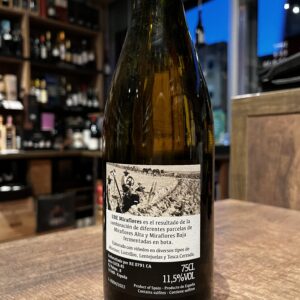
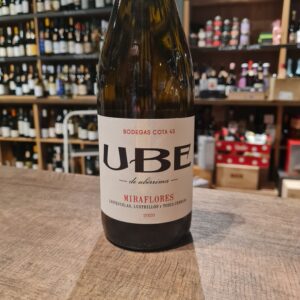 UBE Miraflores is a beautiful introduction to the terroirs of Sanlúcar de Barrameda. This winegrowing region is renowned for its chalky albariza soils and coastal setting, which impart brightness and salinity onto wines produced here. Made in a ‘sherry-like’ style, this wine ages under flor but is not fortified, with a focus on fruit character. The resulting wine is fresh and easy to drink.
UBE Miraflores is a beautiful introduction to the terroirs of Sanlúcar de Barrameda. This winegrowing region is renowned for its chalky albariza soils and coastal setting, which impart brightness and salinity onto wines produced here. Made in a ‘sherry-like’ style, this wine ages under flor but is not fortified, with a focus on fruit character. The resulting wine is fresh and easy to drink. -
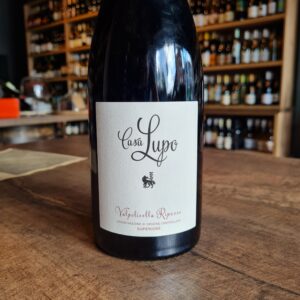 Great Ripasso wine here, any wine enthusiasts will see it as an honest to the point wine on it's Ripasso process. Otherwise known as a ‘Baby Amarone’. The term “Ripasso” means “repassed” referring to the production process whereby regular, fermented Valpolicella (which is a blend of three regional native red grape varieties – Corvina, Rondinella and occasionally Molinara) is added to a cask containing the skins and lees left over from recently fermented Amarone wines. The process of adding (or “repassing”) the lighter Valpolicella wine over the remainders of the “bigger” Amarone wine imparts additional color, texture and flavor to the Valpolicella wine. The “Appassimento” process is an ancient wine making technique used in Northern Italy to make Amarone – the Daddy of Italian wine and its by product Recioto della Valpolicella (a sweet red wine). Grapes are air dried on racks for a period of at least a couple of months and often as many as six, before being pressed. Also, it induces a second fermentation of the wine that increases the wine’s alcoholic content. The end result is a wine that retains the vibrancy of Valpolicella but is darker in colour, bigger and more flavourful and complex than the original Valpolicella. Ripasso wines are rich, full-bodied and share some of the same aroma and flavor profiles as Amarone wines, just less so. Since Ripasso wines are more approachable and less expensive than Amarones they can be enjoyed more regularly. The land is at an altitude of 450 meters above the see level and the soil is made by the alteration of calcareous-fossilized formations, in particular the red flake and biancone marble.After harvesting by hand, the Valpolicella, before aging, is macerated a second time on the mark of the Amarone just drawn and left to rest for about 15-20 days. Then a maturation in oak barrels of 500/1000 LT for 18 months takes place. Ageing in bottles follows that lasts until optimal maturity. It matches perfectly with mushroom risotto, red meat such as barbecue steak or white meat such as stewed rabbit, perfect with cheese of medium maturing.
Great Ripasso wine here, any wine enthusiasts will see it as an honest to the point wine on it's Ripasso process. Otherwise known as a ‘Baby Amarone’. The term “Ripasso” means “repassed” referring to the production process whereby regular, fermented Valpolicella (which is a blend of three regional native red grape varieties – Corvina, Rondinella and occasionally Molinara) is added to a cask containing the skins and lees left over from recently fermented Amarone wines. The process of adding (or “repassing”) the lighter Valpolicella wine over the remainders of the “bigger” Amarone wine imparts additional color, texture and flavor to the Valpolicella wine. The “Appassimento” process is an ancient wine making technique used in Northern Italy to make Amarone – the Daddy of Italian wine and its by product Recioto della Valpolicella (a sweet red wine). Grapes are air dried on racks for a period of at least a couple of months and often as many as six, before being pressed. Also, it induces a second fermentation of the wine that increases the wine’s alcoholic content. The end result is a wine that retains the vibrancy of Valpolicella but is darker in colour, bigger and more flavourful and complex than the original Valpolicella. Ripasso wines are rich, full-bodied and share some of the same aroma and flavor profiles as Amarone wines, just less so. Since Ripasso wines are more approachable and less expensive than Amarones they can be enjoyed more regularly. The land is at an altitude of 450 meters above the see level and the soil is made by the alteration of calcareous-fossilized formations, in particular the red flake and biancone marble.After harvesting by hand, the Valpolicella, before aging, is macerated a second time on the mark of the Amarone just drawn and left to rest for about 15-20 days. Then a maturation in oak barrels of 500/1000 LT for 18 months takes place. Ageing in bottles follows that lasts until optimal maturity. It matches perfectly with mushroom risotto, red meat such as barbecue steak or white meat such as stewed rabbit, perfect with cheese of medium maturing. -
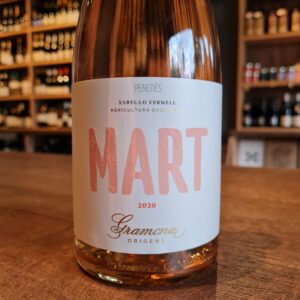 Biodynamic Rosé made from pink skinned Xarel.lo – a variety indigenous to the Penedès region that has been brought back from the brink of extinction. Mediterranean fruits and herbs. Delicate and complex. Recommended spicy dishes such as those found in Japanese, Nikkei, Caribbean and South American cuisine. Rice dishes and seafood. Excellent for aperitifs.
Biodynamic Rosé made from pink skinned Xarel.lo – a variety indigenous to the Penedès region that has been brought back from the brink of extinction. Mediterranean fruits and herbs. Delicate and complex. Recommended spicy dishes such as those found in Japanese, Nikkei, Caribbean and South American cuisine. Rice dishes and seafood. Excellent for aperitifs. -
Out of stock
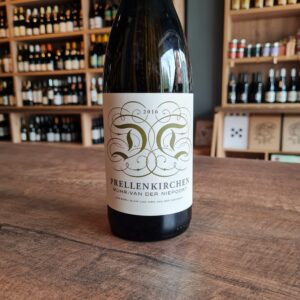 The exciting Muhr-Van der Niepoort project began in 2002 as a collaboration between Austrian PR guru Dorli Muhr and celebrated Portuguese winemaker Dirk Niepoort. Although the name is taken from the village of Prellenkirschen, all of the grapes for the white are sourced from the Spitzerberg, or a continuation of it. A blend of 90% Gruner Veltliner (35 year old vines) and 10% Riesling (planted in 1950), the grapes see some skin contact in the fermentation, imbuing the final wine with tension and extract, a mouth-watering savoury salinity and clearly-delineated spicy flavours of white pepper, fennel and cumin. Deep and a touch wild on the palate but with enormous personality and interest, its deep savoury style will appeal to lovers of edgy yet serious food-friendly whites.
The exciting Muhr-Van der Niepoort project began in 2002 as a collaboration between Austrian PR guru Dorli Muhr and celebrated Portuguese winemaker Dirk Niepoort. Although the name is taken from the village of Prellenkirschen, all of the grapes for the white are sourced from the Spitzerberg, or a continuation of it. A blend of 90% Gruner Veltliner (35 year old vines) and 10% Riesling (planted in 1950), the grapes see some skin contact in the fermentation, imbuing the final wine with tension and extract, a mouth-watering savoury salinity and clearly-delineated spicy flavours of white pepper, fennel and cumin. Deep and a touch wild on the palate but with enormous personality and interest, its deep savoury style will appeal to lovers of edgy yet serious food-friendly whites. -
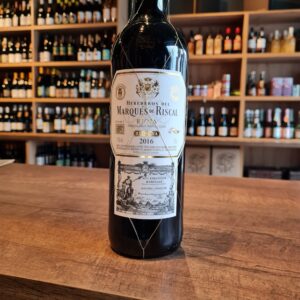 Marqués de Riscal is one of the oldest Rioja wineries. Founded in Elciego (Álava) in 1858 by Guillermo Hurtado de Amézaga. Since the beginning they have always had a clear vocation for creating the quintessential Spanish wines from Rioja. Marqués de Riscal Reserva is a red wine made with Tempranillo, Graciano and Mazuelo from vineyards that are over 40 years old, located on clayey-calcareous soils. After the harvest, the grapes ferment at a controlled temperature with a maceration of 12 days. Once the harvest has finished, the wine goes through a minimum ageing of 2 years in American oak barrels. It is left to stand in the bottle for a minimum of one year before it is launched on to the market. A wine that falls within the canons of Riojan classicism, fresh, fine, elegant and with great ageing potential.
Marqués de Riscal is one of the oldest Rioja wineries. Founded in Elciego (Álava) in 1858 by Guillermo Hurtado de Amézaga. Since the beginning they have always had a clear vocation for creating the quintessential Spanish wines from Rioja. Marqués de Riscal Reserva is a red wine made with Tempranillo, Graciano and Mazuelo from vineyards that are over 40 years old, located on clayey-calcareous soils. After the harvest, the grapes ferment at a controlled temperature with a maceration of 12 days. Once the harvest has finished, the wine goes through a minimum ageing of 2 years in American oak barrels. It is left to stand in the bottle for a minimum of one year before it is launched on to the market. A wine that falls within the canons of Riojan classicism, fresh, fine, elegant and with great ageing potential. -
Out of stock
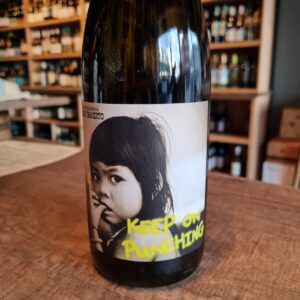 Keep On Punching is Swartland Chenin, but not in the conventional sense. No buttery oak, this is all 100% stainless steel tank to keep that citrus twang just as clean as a whistle. Stylistically this wine fits more closely with the Chenins of the Loire valley - the fruit is apple and pear with some nice zippy white peach. The grapes come from old bush vines that yield small clusters of grapes with great concentration and acidity year on year. Craig's wines have a keen following, and for good reason.After travelling extensively in Portugal and Austria learning his craft, Craig Hawkins returned to South Africa and became the winemaker at top Swartland estate Lammershoek. Craig now makes his own wines from various small, organic vineyard sites in Swartland and makes his wine naturally, with as little intervention as possible.If you like a bit of skin contact (& don't we all), try this!
Keep On Punching is Swartland Chenin, but not in the conventional sense. No buttery oak, this is all 100% stainless steel tank to keep that citrus twang just as clean as a whistle. Stylistically this wine fits more closely with the Chenins of the Loire valley - the fruit is apple and pear with some nice zippy white peach. The grapes come from old bush vines that yield small clusters of grapes with great concentration and acidity year on year. Craig's wines have a keen following, and for good reason.After travelling extensively in Portugal and Austria learning his craft, Craig Hawkins returned to South Africa and became the winemaker at top Swartland estate Lammershoek. Craig now makes his own wines from various small, organic vineyard sites in Swartland and makes his wine naturally, with as little intervention as possible.If you like a bit of skin contact (& don't we all), try this! -
Out of stock
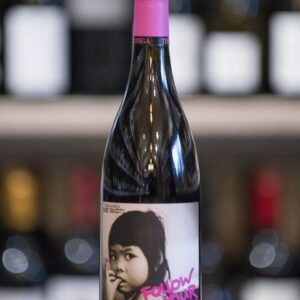 Craig and Carla Hawkins launched Testalonga in the north of Swartland, South Africa in 2008. They are part of a revolutionary ground swell taking place in South African wine, where traditions are being challenged and brave new territory is being explored. The painfully small amount of wine that this duo produces gets snapped up in short order the world over. Known for their striking intensity and nervy energy, Craig and Carla's wines are on the cutting edge of the natural wine movement in their country.This is the lightest, daintiest version of Carignan one could imagine. It's got more in common with, say a Jura rouge or something Cab-Franc-like out of the Loire Valley than a classic Rhone red.It's fresh, racy, filled with character and seasoned with a little wildness. Great with on summer afternoon, first courses, seasoned vegetables. Enjoy
Craig and Carla Hawkins launched Testalonga in the north of Swartland, South Africa in 2008. They are part of a revolutionary ground swell taking place in South African wine, where traditions are being challenged and brave new territory is being explored. The painfully small amount of wine that this duo produces gets snapped up in short order the world over. Known for their striking intensity and nervy energy, Craig and Carla's wines are on the cutting edge of the natural wine movement in their country.This is the lightest, daintiest version of Carignan one could imagine. It's got more in common with, say a Jura rouge or something Cab-Franc-like out of the Loire Valley than a classic Rhone red.It's fresh, racy, filled with character and seasoned with a little wildness. Great with on summer afternoon, first courses, seasoned vegetables. Enjoy -
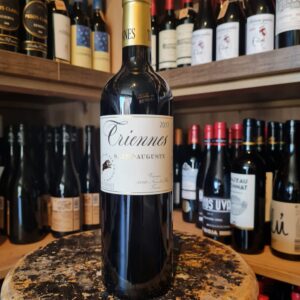 Saint Auguste is a selection of the best cuvées of Syrah, Cabernet-Sauvignon and Merlot. The robe is rich dark purple with bright ruby highlights. It offers alluring aromas of ripe black cherries, nutmeg and clove. It is full and concentrated and is a wine that can be enjoyed upon release and over the following ten to fifteen years.
Saint Auguste is a selection of the best cuvées of Syrah, Cabernet-Sauvignon and Merlot. The robe is rich dark purple with bright ruby highlights. It offers alluring aromas of ripe black cherries, nutmeg and clove. It is full and concentrated and is a wine that can be enjoyed upon release and over the following ten to fifteen years. -
 This is the first wine made by Esporão back in 1985. Label illustrated by António Poppe that changes with every organic vintage. Classic wine style made from estate grown grapes that shows the consistency and the rich, ripe fruit characters which are typical of the best Alentejo red wines. Deep dark red colour with intense spicy aroma of mature red berry fruits with discrete oak complexity. On the palate it is elegant, dense and creamy.
This is the first wine made by Esporão back in 1985. Label illustrated by António Poppe that changes with every organic vintage. Classic wine style made from estate grown grapes that shows the consistency and the rich, ripe fruit characters which are typical of the best Alentejo red wines. Deep dark red colour with intense spicy aroma of mature red berry fruits with discrete oak complexity. On the palate it is elegant, dense and creamy. -
Out of stock
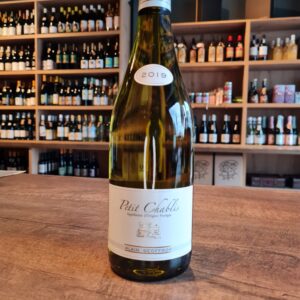 This wine is lively, pleasant and fruity. Lovely citrus flavours on a fine, minerally background. Alain Geoffroy’s vineyard is located on Kimmeridgian limestone with 15-20 years old vines, that has made the mineral-driven wines of Chablis so famous. Making this a very serious wine for its price and a go-to white for summer lunches, big dinner parties, fish, seafood, goats cheese, crunchy salads and filling the wine rack. Nothing little about this Petit-Chablis and without the price of a Grand Cru.
This wine is lively, pleasant and fruity. Lovely citrus flavours on a fine, minerally background. Alain Geoffroy’s vineyard is located on Kimmeridgian limestone with 15-20 years old vines, that has made the mineral-driven wines of Chablis so famous. Making this a very serious wine for its price and a go-to white for summer lunches, big dinner parties, fish, seafood, goats cheese, crunchy salads and filling the wine rack. Nothing little about this Petit-Chablis and without the price of a Grand Cru. -
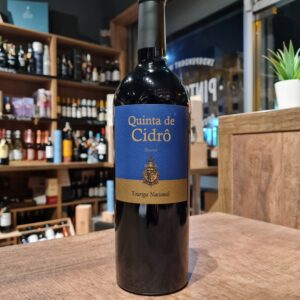 I have been chasing a 100% Touriga Nacional for a while now, with some disappointments in the middle. Mostly due to knowing the full potential of Touriga Nacional and what can be done with it. Was loosing faith(Poor supplier offering in Ireland) and was actively looking to import myself a few options until I stumbled upon this gem. This wine is the example where no one should judge a book by its cover. Across all Companhia Velha Wines the labels are just minimal, classy but not in the way you would think. Has a bit of I don't give a damn about them and that subtlety actually impresses me even further. No distractions to be added here!!! Bear in mind this winery was one of the first if not the first Wine family business(1756) in the Douro Valley(1763) and it was full integrated when it became the first official wine region in the world. Quinta de Cidrô is located at São João da Pesqueira, which is one of the most highly regarded areas of Douro Valley. Throughout the last 20 years, Cidrô has been transformed into an experimental-model vineyard for the entire region. In virgin soils, cutting edge techniques were employed to plant 150 ha of the best varieties, creating one of the largest surfaces of single vineyard in the entire Douro Region. In the most privileged location, international varieties perform equally well as the local grapes. Chardonnay, Sauvignon Blanc, Viognier, Pinot Noir, and the adaptable Cabernet Sauvignon are some of the foreign varieties that here express their best qualities when vinified by the extensive winemaking know-how present at the Company. Touriga Nacional is Portugal’s star variety and the dominant red grape at Quinta de Cidrô. The altitude of this Quinta provides excellent freshness and levels of acidity, ideal conditions for an elegant red wine. Touriga Nacional is a versatile grape, with its main characteristics being the small bundle, its low yield and jagged leaf. Its presence in the vines is intimidating, as it requires a constant care for its wild and rebellious character of growing disorderly. At Quinta de Cidrô, Touriga Nacional was adapted to a less habitual place, as it was mostly planted in low altitude vineyards and subject to high temperatures; the opposite of Quinta de Cidrô. Personally I love it on its own with at least 45 minutes decanting or enjoy really slow the very first drop. Winemakers suggestion for this stunning wine are: Rump Steak, Pork Leg, Parmigiano Cheese and Dark Chocolate.
I have been chasing a 100% Touriga Nacional for a while now, with some disappointments in the middle. Mostly due to knowing the full potential of Touriga Nacional and what can be done with it. Was loosing faith(Poor supplier offering in Ireland) and was actively looking to import myself a few options until I stumbled upon this gem. This wine is the example where no one should judge a book by its cover. Across all Companhia Velha Wines the labels are just minimal, classy but not in the way you would think. Has a bit of I don't give a damn about them and that subtlety actually impresses me even further. No distractions to be added here!!! Bear in mind this winery was one of the first if not the first Wine family business(1756) in the Douro Valley(1763) and it was full integrated when it became the first official wine region in the world. Quinta de Cidrô is located at São João da Pesqueira, which is one of the most highly regarded areas of Douro Valley. Throughout the last 20 years, Cidrô has been transformed into an experimental-model vineyard for the entire region. In virgin soils, cutting edge techniques were employed to plant 150 ha of the best varieties, creating one of the largest surfaces of single vineyard in the entire Douro Region. In the most privileged location, international varieties perform equally well as the local grapes. Chardonnay, Sauvignon Blanc, Viognier, Pinot Noir, and the adaptable Cabernet Sauvignon are some of the foreign varieties that here express their best qualities when vinified by the extensive winemaking know-how present at the Company. Touriga Nacional is Portugal’s star variety and the dominant red grape at Quinta de Cidrô. The altitude of this Quinta provides excellent freshness and levels of acidity, ideal conditions for an elegant red wine. Touriga Nacional is a versatile grape, with its main characteristics being the small bundle, its low yield and jagged leaf. Its presence in the vines is intimidating, as it requires a constant care for its wild and rebellious character of growing disorderly. At Quinta de Cidrô, Touriga Nacional was adapted to a less habitual place, as it was mostly planted in low altitude vineyards and subject to high temperatures; the opposite of Quinta de Cidrô. Personally I love it on its own with at least 45 minutes decanting or enjoy really slow the very first drop. Winemakers suggestion for this stunning wine are: Rump Steak, Pork Leg, Parmigiano Cheese and Dark Chocolate. -
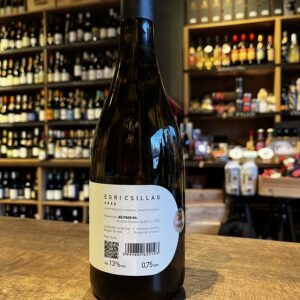
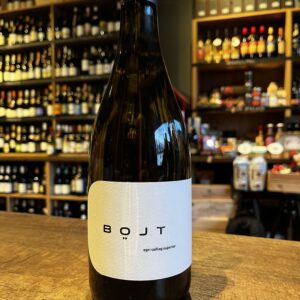 One of our best selling fine whites for a reason. Floral and herbal nose. Fresh on the palate. Full of nectarines, a touch of grapefruit and a lean mineral finish. Gergo Bojt is a revolutionary young producer in the northern Hungarian wine region, Eger. A town full of history and rich culture in winemaking. His four legged companion, Buddy, always follows him around the vineyard. They form a great team with a sense of playfulness showing through the wines, too. This wine will appeal to you if you like Albarino or dry Riesling. Superb with oysters.
One of our best selling fine whites for a reason. Floral and herbal nose. Fresh on the palate. Full of nectarines, a touch of grapefruit and a lean mineral finish. Gergo Bojt is a revolutionary young producer in the northern Hungarian wine region, Eger. A town full of history and rich culture in winemaking. His four legged companion, Buddy, always follows him around the vineyard. They form a great team with a sense of playfulness showing through the wines, too. This wine will appeal to you if you like Albarino or dry Riesling. Superb with oysters. -
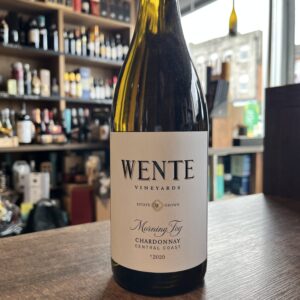 Estate Grown Morning Fog Chardonnay is named for the morning coastal fog pushed by Pacific wind streams into the bowl of the San Francisco Bay. This daily phenomenon moderates the climate to produce excellent, beautifully balanced Chardonnay.Wente Vineyards is one of the oldest, family run wineries, in America having been established in 1883. The Estate extends to some 3000 acres, 2000 in the San Francisco Bay appellation and 1000 acres in Arroyo Seco, Monterey to the south.Pioneers of the Californian Chardonnay clone Wente claim 80% of all Californian Chardonnay is from the Wente original clone. The family, German in origin, has long been innovators introducing stainless steel fermentation tanks in the 60’s and introducing varietal labelled wines as long ago as the 1930’s. Today, fifth generation winemaker Karl D. Wente carries on the family winemaking tradition. Such a smooth wine is delicious to enjoy alone at any time, but if you prefer to pair it, go for light flavoured meals like white meats, pastas, risottos with no added spice.
Estate Grown Morning Fog Chardonnay is named for the morning coastal fog pushed by Pacific wind streams into the bowl of the San Francisco Bay. This daily phenomenon moderates the climate to produce excellent, beautifully balanced Chardonnay.Wente Vineyards is one of the oldest, family run wineries, in America having been established in 1883. The Estate extends to some 3000 acres, 2000 in the San Francisco Bay appellation and 1000 acres in Arroyo Seco, Monterey to the south.Pioneers of the Californian Chardonnay clone Wente claim 80% of all Californian Chardonnay is from the Wente original clone. The family, German in origin, has long been innovators introducing stainless steel fermentation tanks in the 60’s and introducing varietal labelled wines as long ago as the 1930’s. Today, fifth generation winemaker Karl D. Wente carries on the family winemaking tradition. Such a smooth wine is delicious to enjoy alone at any time, but if you prefer to pair it, go for light flavoured meals like white meats, pastas, risottos with no added spice. -
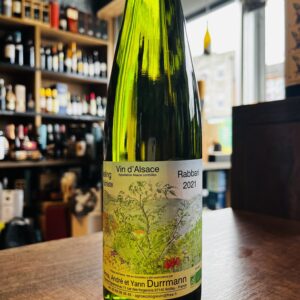 This wine is imported directly and only for Pinto Wines Riesling on Schist makes its terroir apparent with a livewire acidity and snap, rocky, chalky and mineral. Low yielding parcels. Long and driving, a little structure from 2022. The Durrmann family are making wine from their old family house in the middle of Andlau, a beautiful village nestled on the first slopes of the Vosges mountains south-west of Strasbourg. With a surface of only 1,5 hectare at the beginning in 1979, the domaine gradually reached a total surface of seven hectares after André decided to move back to farming and pieced it together from abandoned vineyard sites that were hard to work and no longer commercially viable, coming from his grandfather who made shoes to supplement the farm income. This lack of an established and family-based wine making tradition initially presented a weakness because the whole business had to be built, but it is also a strength because the company wasn’t limited to traditional customs, and therefore has always been oriented toward innovation. The vineyards are now scattered on about 30 spots around the village. They added parcels progressively when opportunities showed up and looked also for different soil qualities so that the cuvées express several terroirs. The Durrmans think that the quality of the wine is created by the work in the vineyard, that’s why their objective is its preservation. The wines are being disturbed as little as possible. They do not add any oenological product to change the natural taste of the wines. The production is partly vinified in inox tank and partly in old wooden casks. Son Yann has worked in the domaine since he was a child and officially took over the running of the business a year ago. André was among the first wave of organic winemakers in Alsace converting in 1998, Yann has then taken this a step further applying a more natural approach in the cellar. Selected cuvées are produced without sulfur addition since 2007. The Durrmanns are true eco warriors only having electric cars and using solar energy for hot water and heating. Pair it with Pork, Seafood, Curries, Spicy dishes
This wine is imported directly and only for Pinto Wines Riesling on Schist makes its terroir apparent with a livewire acidity and snap, rocky, chalky and mineral. Low yielding parcels. Long and driving, a little structure from 2022. The Durrmann family are making wine from their old family house in the middle of Andlau, a beautiful village nestled on the first slopes of the Vosges mountains south-west of Strasbourg. With a surface of only 1,5 hectare at the beginning in 1979, the domaine gradually reached a total surface of seven hectares after André decided to move back to farming and pieced it together from abandoned vineyard sites that were hard to work and no longer commercially viable, coming from his grandfather who made shoes to supplement the farm income. This lack of an established and family-based wine making tradition initially presented a weakness because the whole business had to be built, but it is also a strength because the company wasn’t limited to traditional customs, and therefore has always been oriented toward innovation. The vineyards are now scattered on about 30 spots around the village. They added parcels progressively when opportunities showed up and looked also for different soil qualities so that the cuvées express several terroirs. The Durrmans think that the quality of the wine is created by the work in the vineyard, that’s why their objective is its preservation. The wines are being disturbed as little as possible. They do not add any oenological product to change the natural taste of the wines. The production is partly vinified in inox tank and partly in old wooden casks. Son Yann has worked in the domaine since he was a child and officially took over the running of the business a year ago. André was among the first wave of organic winemakers in Alsace converting in 1998, Yann has then taken this a step further applying a more natural approach in the cellar. Selected cuvées are produced without sulfur addition since 2007. The Durrmanns are true eco warriors only having electric cars and using solar energy for hot water and heating. Pair it with Pork, Seafood, Curries, Spicy dishes -
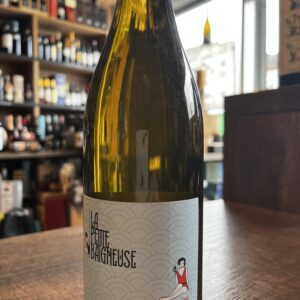 On the border between Roussillon and Corbières, in the heart of the Maury appellation, is the Domaine de la Petite Baigneuse . Philippe Wies, accompanied by his wife Céline, settled at the end of the 2000s, on the superb Maury shale terroirs, at an altitude of 350 meters with breathtaking views of the big blue sea. Surrounded by scrubland and protected by an environment of cliffs, the 14 hectares of vines benefit from a Mediterranean climate tempered by the wind and maritime inlets. Organic since the beginning of the adventure, the Petite Baigneuse estate also practices biodynamics and only works the soil very little. Some plowing is then carried out with a tractor and a tracker so as not to overturn the horizons. Not far from Calce's friends in the people of La Nouvelle Donne , and Domaine Jean-Philippe Padié , Philippe Wies is today an essential figure in the world of natural wines in the south of France. "Juste Ciel", a wine that calls for summer, fresh grilled fish, marinated supions, sea urchins, carpaccio de Saint Jacques.... In short, "La Petite Baigneuse" delivers here a wine to be enjoyed by the poolside with a Mediterranean meal thanks to its delicacy, its freshness and its notes of candied fruits. A very nice white wine to share with a nice meal.
On the border between Roussillon and Corbières, in the heart of the Maury appellation, is the Domaine de la Petite Baigneuse . Philippe Wies, accompanied by his wife Céline, settled at the end of the 2000s, on the superb Maury shale terroirs, at an altitude of 350 meters with breathtaking views of the big blue sea. Surrounded by scrubland and protected by an environment of cliffs, the 14 hectares of vines benefit from a Mediterranean climate tempered by the wind and maritime inlets. Organic since the beginning of the adventure, the Petite Baigneuse estate also practices biodynamics and only works the soil very little. Some plowing is then carried out with a tractor and a tracker so as not to overturn the horizons. Not far from Calce's friends in the people of La Nouvelle Donne , and Domaine Jean-Philippe Padié , Philippe Wies is today an essential figure in the world of natural wines in the south of France. "Juste Ciel", a wine that calls for summer, fresh grilled fish, marinated supions, sea urchins, carpaccio de Saint Jacques.... In short, "La Petite Baigneuse" delivers here a wine to be enjoyed by the poolside with a Mediterranean meal thanks to its delicacy, its freshness and its notes of candied fruits. A very nice white wine to share with a nice meal. -
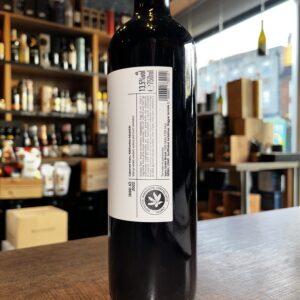
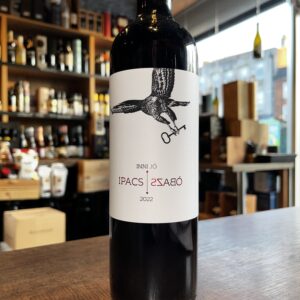 Those who have tasted this wine know that the ‘simplicity’ of its name is about a philosophy, a family story; yet the wine is seriously complex. A blend of Cabernet Franc and Kékfrankos aged in small barrels – You can expect a seriously complex and rich red wine, while its velvety juiciness and ripe fruitiness really make it dangerously good to drink! 'Inni Jó' translates to 'Drinking is Good' "My younger son Vencel tasted a sip and said, it feels good to drink, then my eldest, Vince, pondered on ‘Drinking is good!’ – so my three-year-old instinctively articulated the essence we all have been working towards for generations." - Ipacs tells the story behind the label.
Those who have tasted this wine know that the ‘simplicity’ of its name is about a philosophy, a family story; yet the wine is seriously complex. A blend of Cabernet Franc and Kékfrankos aged in small barrels – You can expect a seriously complex and rich red wine, while its velvety juiciness and ripe fruitiness really make it dangerously good to drink! 'Inni Jó' translates to 'Drinking is Good' "My younger son Vencel tasted a sip and said, it feels good to drink, then my eldest, Vince, pondered on ‘Drinking is good!’ – so my three-year-old instinctively articulated the essence we all have been working towards for generations." - Ipacs tells the story behind the label. -
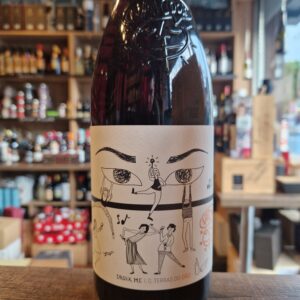 Nat Cool is an innovative, naturally “cool and funky” concept initiated by Niepoort in the Vinho Verde wine region. The movement later expanded into Bairrada and the Douro Valley and is now represented in various Portuguese as well as international wine regions. Nat Cool is not just about producing low-intervention wines – it embodies a movement uniting many different producers striving towards a shared goal of crafting uncomplicated, light and easy-to-drink wines. In 2020, the Nat Cool “family” grew, with its foray into Portugal’s Dão region. It is here, on the slopes of the Serra da Estrela Mountain Range that the DrinkMe Nat Cool is created and where we explore the region’s potential for elegant, fresh and straight-forward wines. Pair it with Light and simple dishes as well as comfort food
Nat Cool is an innovative, naturally “cool and funky” concept initiated by Niepoort in the Vinho Verde wine region. The movement later expanded into Bairrada and the Douro Valley and is now represented in various Portuguese as well as international wine regions. Nat Cool is not just about producing low-intervention wines – it embodies a movement uniting many different producers striving towards a shared goal of crafting uncomplicated, light and easy-to-drink wines. In 2020, the Nat Cool “family” grew, with its foray into Portugal’s Dão region. It is here, on the slopes of the Serra da Estrela Mountain Range that the DrinkMe Nat Cool is created and where we explore the region’s potential for elegant, fresh and straight-forward wines. Pair it with Light and simple dishes as well as comfort food -
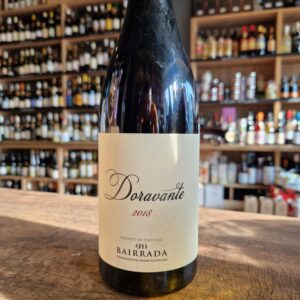
Nuno's philosophy is in keeping with this. In his own words, his wines are "a pursuit for balance with the utmost respect for nature".
Think of Doravante as an old-school claret, with lighter red fruit flavour and fresh pencil shaving mineral character. The blend is Baga and the better-known Touriga Nacional, fresh and elegant and long. So delicious and such an exciting region of Portugal.
Excellent served with strong dark meat and game dishes
-
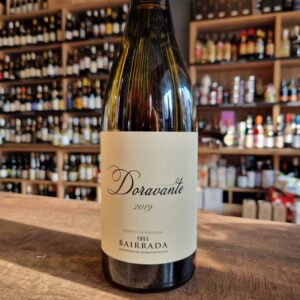
Excellent alternative for Burgundy 1er cru's or Villages.
This wine was born from Arinto vines around 30 years old and very old vines from Bical and Cercial. It is a different approach to these grapes and to the expression of the clay-limestone soils and the Atlantic climate of the region. The 2018 harvest turns the page to a more complex and creamy profile but with the lightness and freshness of always.
The producer Nuno Mira do Ó is passionate about authentic wines that are able to translate the “terroir” where they come from, made with indigenous grape varieties, with minimal intervention and respect for nature, with the potential to age and especially that provide pleasure to those who drink them
Excellent to accompany soft cheeses, cod, octopus and white meats.
-
 Menina d’Uva is a small winery located in Uva, a remote village in the quiet and desolate countryside of the Northeast of Portugal. Female winemaker Aline Domingues moved from Paris to this area from which her parents had emigrated to Paris to give their children better opportunities. A controversial move within the family but one that I wholeheartedly support. Aline clearly is a talented winemaker crafting beautifully pure wines. Made from 70% red grapes (including Bastardo, known in the Jura as Trousseau) and 30% white grapes including Malvasia and white Bastardo. It’s still a hearthy red that’s crispy and refreshing; cherries, pomegranate with a beautiful smell of the forest. Highly recommended.
Menina d’Uva is a small winery located in Uva, a remote village in the quiet and desolate countryside of the Northeast of Portugal. Female winemaker Aline Domingues moved from Paris to this area from which her parents had emigrated to Paris to give their children better opportunities. A controversial move within the family but one that I wholeheartedly support. Aline clearly is a talented winemaker crafting beautifully pure wines. Made from 70% red grapes (including Bastardo, known in the Jura as Trousseau) and 30% white grapes including Malvasia and white Bastardo. It’s still a hearthy red that’s crispy and refreshing; cherries, pomegranate with a beautiful smell of the forest. Highly recommended. -
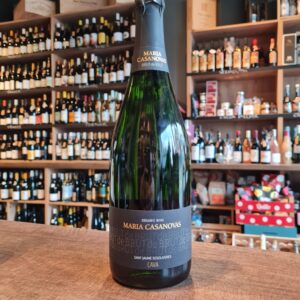 The Bodega or Cava Maria Casanovas is located in the heart of the Penedès, in Sant Sadurní d'Anoia, the centre of Cava production. It is owned by the Casanovas family and managed by three children of Maria Casanovas. Jordi and Jacint are responsible for the vineyards and the cellar, Rosa for administration and marketing. Maria Casanovas' parents were already grape growers and sold their produce to the large cava wineries. Cava has been produced under their own name since 1984. 13 hectares are owned and planted with the local grape varieties Xarel-lo, Parellada and Macabeo (Viura) as well as the international varieties Pinot Noir and Chardonnay. Maria Casanovas was one of the pioneers who introduced Pinot Noir to Penedès. Fossils can be found occasionally in the calcareous, gravelly clay soils. Food pairing suggestion: Apéro pastries, Tagliatelle al tartufo, Vegetable pie, Salad with vegetables, pulses, pasta
The Bodega or Cava Maria Casanovas is located in the heart of the Penedès, in Sant Sadurní d'Anoia, the centre of Cava production. It is owned by the Casanovas family and managed by three children of Maria Casanovas. Jordi and Jacint are responsible for the vineyards and the cellar, Rosa for administration and marketing. Maria Casanovas' parents were already grape growers and sold their produce to the large cava wineries. Cava has been produced under their own name since 1984. 13 hectares are owned and planted with the local grape varieties Xarel-lo, Parellada and Macabeo (Viura) as well as the international varieties Pinot Noir and Chardonnay. Maria Casanovas was one of the pioneers who introduced Pinot Noir to Penedès. Fossils can be found occasionally in the calcareous, gravelly clay soils. Food pairing suggestion: Apéro pastries, Tagliatelle al tartufo, Vegetable pie, Salad with vegetables, pulses, pasta -
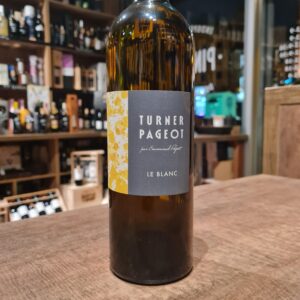 Australian scientist Karen Turner and her husband Emmanuel farm 10 hectares in the Languedoc bring you this incredible intro to orange wine! The 3 grapes here are fermented like a red wine, skins, stalks, and all-- making for white with the tannins and structure of a red. Karen’s says her goal with ‘Le Blanc’ is to bring body and freshness to the wine. The north-facing slopes where their vineyards grow on help to ensure a long and even maturation for the grapes. While Marsanne is not usually an aromatic varietal, Karen’s use of open vats brings out the heady aromas of tangerine and mango. Full-bodied and approachable, it smells like orange rinds and white flowers wilting in the sun, and tastes like yellow peaches, those tangerines and dry, dusty earth, but never loses its identity as a white wine. LADY IN CHARGE: While husband Emmanuel manages the vineyards, the real star is his wife Karen, who makes the wine and also works as the head winemaker and manager of another (very famous) Languedoc winery, Prieuré de Saint Jean de Bébian. Serious girl boss! Decant for 20 minutes before enjoying. It’ll open up and reveal its prettiness with air. Perfect for poultry, fish, cheese and early dishes. Also wonderful in itself.
Australian scientist Karen Turner and her husband Emmanuel farm 10 hectares in the Languedoc bring you this incredible intro to orange wine! The 3 grapes here are fermented like a red wine, skins, stalks, and all-- making for white with the tannins and structure of a red. Karen’s says her goal with ‘Le Blanc’ is to bring body and freshness to the wine. The north-facing slopes where their vineyards grow on help to ensure a long and even maturation for the grapes. While Marsanne is not usually an aromatic varietal, Karen’s use of open vats brings out the heady aromas of tangerine and mango. Full-bodied and approachable, it smells like orange rinds and white flowers wilting in the sun, and tastes like yellow peaches, those tangerines and dry, dusty earth, but never loses its identity as a white wine. LADY IN CHARGE: While husband Emmanuel manages the vineyards, the real star is his wife Karen, who makes the wine and also works as the head winemaker and manager of another (very famous) Languedoc winery, Prieuré de Saint Jean de Bébian. Serious girl boss! Decant for 20 minutes before enjoying. It’ll open up and reveal its prettiness with air. Perfect for poultry, fish, cheese and early dishes. Also wonderful in itself. -
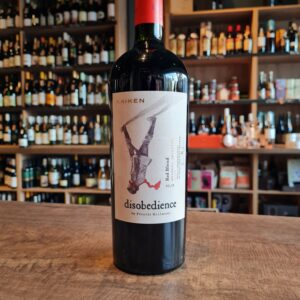 This wine celebrates a collaboration of many years between well-known Argentinian chef Francis Mallmann and Kaiken estate. Known for his distinct style of open fire cooking, ably captured in the first season of Netflix’s Chef’s Table, Mallman's unstoppable and unique nature is captured by the name 'Disobedience'. Kaikenes are wild geese, native to Patagonia, that fly across the Andes between Chile and Argentina. Montes, the Chilean winery, crossed the Andes in the same way to set up in Mendoza. Their vineyards are situated in the heart of Mendoza and further to the south in Valle de Uco, where many of the premium producers are now sourcing their fruit. The focus is primarily on Malbec and Cabernet Sauvignon, a variety that has been somewhat forgotten as Malbec has surfed one wave of success after another in the past decade. Kaiken's own vineyards supply 70% of their production requirements and 30% is from vineyards that they control. The grapes are sourced from Kaiken's vineyards in Altamira in the Uco Valley and Vistalba in the Luján de Cuyo region. Vistalba's chalk and sandy soil, at 1,200m altitude, imparts an elegant and fruit-driven character to the wine.The alluvial and loam soil of the Luján de Cuyo forces vines to penetrate deep into the soil, contributing deep fruit concentration and tannin. As Francis Mallmann says, wine is a celebration. And this is a wine created to celebrate friendship, love, reunion... And celebrate an act of freedom, no one can decide how to do it.
This wine celebrates a collaboration of many years between well-known Argentinian chef Francis Mallmann and Kaiken estate. Known for his distinct style of open fire cooking, ably captured in the first season of Netflix’s Chef’s Table, Mallman's unstoppable and unique nature is captured by the name 'Disobedience'. Kaikenes are wild geese, native to Patagonia, that fly across the Andes between Chile and Argentina. Montes, the Chilean winery, crossed the Andes in the same way to set up in Mendoza. Their vineyards are situated in the heart of Mendoza and further to the south in Valle de Uco, where many of the premium producers are now sourcing their fruit. The focus is primarily on Malbec and Cabernet Sauvignon, a variety that has been somewhat forgotten as Malbec has surfed one wave of success after another in the past decade. Kaiken's own vineyards supply 70% of their production requirements and 30% is from vineyards that they control. The grapes are sourced from Kaiken's vineyards in Altamira in the Uco Valley and Vistalba in the Luján de Cuyo region. Vistalba's chalk and sandy soil, at 1,200m altitude, imparts an elegant and fruit-driven character to the wine.The alluvial and loam soil of the Luján de Cuyo forces vines to penetrate deep into the soil, contributing deep fruit concentration and tannin. As Francis Mallmann says, wine is a celebration. And this is a wine created to celebrate friendship, love, reunion... And celebrate an act of freedom, no one can decide how to do it. -
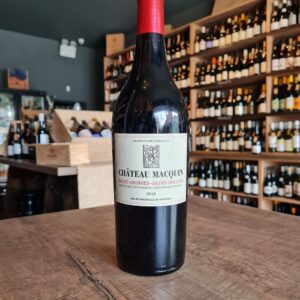 Wines have been made at Château Macquin since 1885, when the first cellar was developed by François-Albert Macquin. François was the first to re-plant vines in the Saint-Émilion region following the phylloxera outbreak in the 19th century. Today, the Château is run by his grandson Denis and wife Christine Corre-Macquin, who own 27 hectares of vines in both Saint-Émilion and Pomerol. They are involved in every vine-growing and winemaking decision to ensure the high quality of their wine remains consistent every vintage. Château Macquin is located just three kilometres north of Saint-Émilion, in the small village of Saint-Georges, the smallest of all Bordeaux appellations (180 hectares). However, at its peak of 89 metres above sea level, Saint-Georges enjoys one of the best elevations on the right bank, giving the wines freshness and concentration. The south facing vines are planted on clay and limestone soils and range from 15 to 60 years old. The vines are sustainably farmed, without the use of herbicides, fertilisers, or other harmful chemicals. The outstanding weather conditions in August and subsequent Indian summer resulted in red wine grapes with a particularly high sugar content, satisfactory levels of tartaric acid and promising aromatic potential. The thick skins and concentration of tannins required meticulous care during extraction. The Merlot wines are deep and concentrated,while maintaining freshness in spite of their relatively high alcohol level. Enjoyed with Ratatouille, Tournedos, grilled lamb chops.
Wines have been made at Château Macquin since 1885, when the first cellar was developed by François-Albert Macquin. François was the first to re-plant vines in the Saint-Émilion region following the phylloxera outbreak in the 19th century. Today, the Château is run by his grandson Denis and wife Christine Corre-Macquin, who own 27 hectares of vines in both Saint-Émilion and Pomerol. They are involved in every vine-growing and winemaking decision to ensure the high quality of their wine remains consistent every vintage. Château Macquin is located just three kilometres north of Saint-Émilion, in the small village of Saint-Georges, the smallest of all Bordeaux appellations (180 hectares). However, at its peak of 89 metres above sea level, Saint-Georges enjoys one of the best elevations on the right bank, giving the wines freshness and concentration. The south facing vines are planted on clay and limestone soils and range from 15 to 60 years old. The vines are sustainably farmed, without the use of herbicides, fertilisers, or other harmful chemicals. The outstanding weather conditions in August and subsequent Indian summer resulted in red wine grapes with a particularly high sugar content, satisfactory levels of tartaric acid and promising aromatic potential. The thick skins and concentration of tannins required meticulous care during extraction. The Merlot wines are deep and concentrated,while maintaining freshness in spite of their relatively high alcohol level. Enjoyed with Ratatouille, Tournedos, grilled lamb chops.


